Home » Search results for 'sip'
Search Results for: sip
Interconnecting Incredible PBX Servers with PJsip

Much has been made of the lack of multi-tenant functionality with Asterisk® and FreePBX®. Today we’ll show you how to interconnect as many Asterisk servers as you like and make transparent calls between all of them at zero cost. Setup time is under 5 minutes per server. When you couple PBXs with distributed infrastructure and inexpensive cloud servers costing $25 or less a year and on-premise virtual machine platforms including Proxmox, VMware ESXi, VirtualBox, Windows 11 WSL, and Mac UTM, it makes little sense in terms of reliability and redundancy to put all your eggs in one basket with a MultiTenant telephony solution.
PJsip Interconnection Design
Our basic design goes like this. Create as many decentralized Incredible PBX platforms as you need to cover the various locations of your business. Whether that’s two cities or eighty-nine, the design is the same. Next, use the same extension design at every site. For example, in each location choose 3-digit extensions in the 100 range for management offices and the receptionist, in the 200 range for human resources, in the 300 range for IT services, and so on. Next, number your locations. For nine or fewer cities, use single digits. For up to 89, use two digits beginning with 10. We actually use the last octet of our server’s OpenVPN IP address for the dialing prefix. For our example, we’ll use 1 for the Atlanta office, 2 for Dallas, and 3 for Boston. When someone in Atlanta wishes to call the main human resources number in Dallas, the user would dial 2200. For Boston, they’d dial 3200. And, when someone in Dallas or Boston wishes to reach the main HR number in Atlanta, they’d dial 1200. Assuming the receptionist in each location has extension 100, callers in Dallas would dial 1100 for Atlanta and 3100 for Boston. Hopefully, you get the idea now. Sketch these out on a piece a paper until it all makes sense to you.
You’ll need static IP addresses for each of your Incredible PBX servers. But, if one or more of your servers are sitting behind a corporate firewall, that’s not a deal breaker. Simply set up an OpenVPN network and assign a private OpenVPN IP address to each server. Then use these OpenVPN IP addresses in interconnecting your servers rather than static, public IP addresses. OpenVPN addresses are automatically whitelisted in the Incredible PBX firewall. For other IP addresses, you’ll need to whitelist them using the add-ip utility in the /root folder of each of your PBXs. Be sure to also add the IP addresses of the servers to the ignoreip list in /etc/fail2ban/jail.conf. Note in our design that, for security reasons, PJsip trunks must be created on BOTH the sending and receiving PBXs before interconnected calls between the servers will successfully complete. You wouldn’t want strangers making PJsip calls through your servers. In the alternative, if you only want to enable outbound calls from one PBX to another, you can avoid creating a PJsip trunk on the destination server and instead enable Outbound Authentication on the originating server. In this case, you also will need to enter extension credentials from the destination server in the PJsip Username and Secret fields. But let’s continue on assuming you want calls to flow in both directions.
Using our 3-city example, let’s begin by configuring the Atlanta PBX using the FreePBX GUI. Login to the web interface as admin and navigate to Connectivity -> Trunks. We want to create two PJsip trunks, one to connect to Dallas and another to connect to Boston. Similarly, in Dallas, we’ll create PJsip trunks for Atlanta and Boston. And, in Boston, we’ll create PJsip trunks for Atlanta and Dallas.
Configuring PJsip Trunks For Each Location
On the Atlanta PBX, click the Add Trunk button and choose Add SIP (chan_pjsip) Trunk. For the first PJsip trunk, in the General tab, let’s keep it simple and enter Trunk Name as Dallas. Leave the remaining default settings and click the pjSIP Settings tab. Leave all of the default settings as they are in both the Advanced and Codecs tabs. In the General tab, change the Authentication and Registration settings to None. For the SIP Server IP address, enter the IP address (or OpenVPN address) of the Dallas server. For the SIP Server Port, enter 5061. Finally, change the Context entry to from-internal. That’s all the settings you’ll need. So click Submit and Apply Config when prompted. Repeat the drill for Boston.
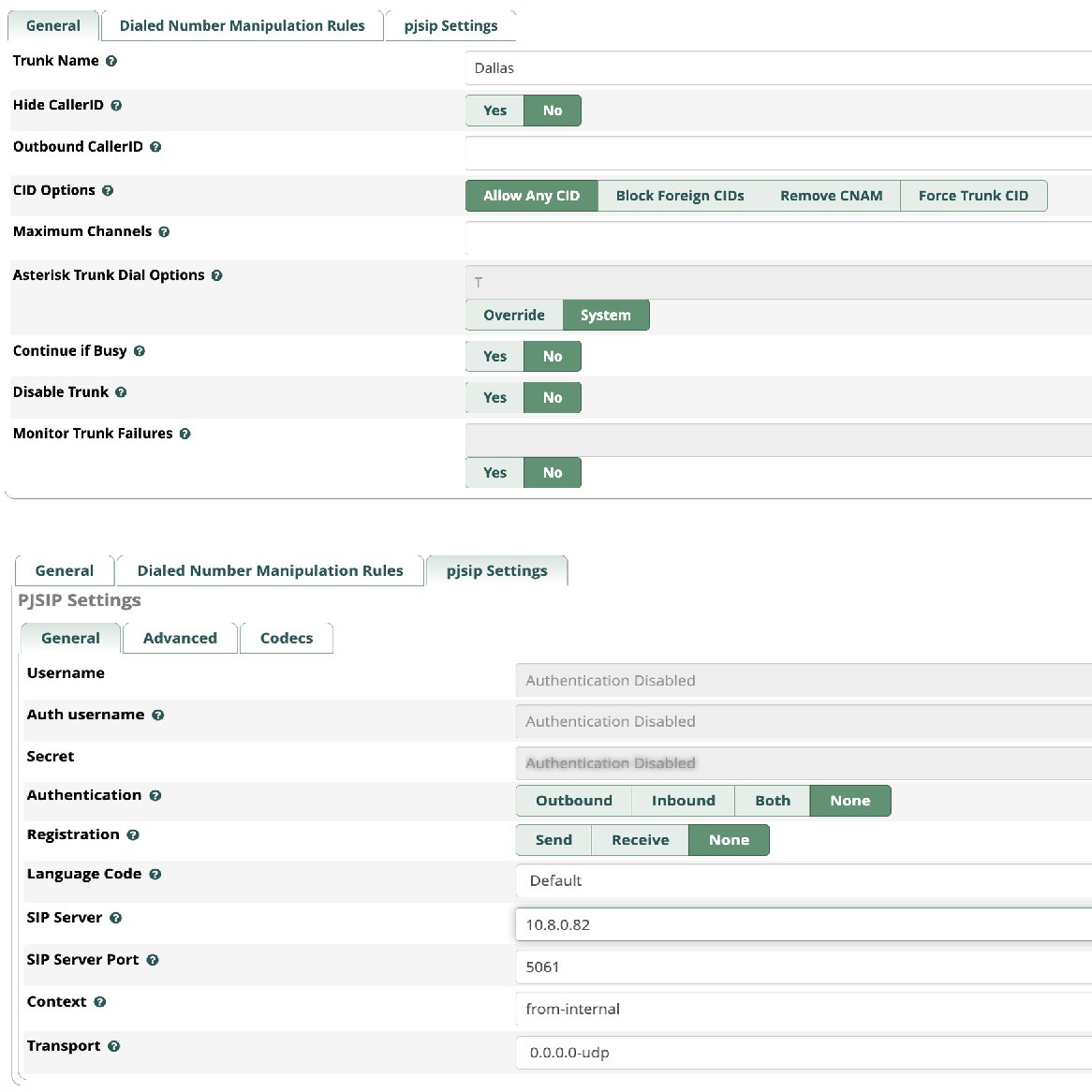
Configuring Outbound Routes For Each Location
Next, we need to create two Outbound Routes for calls to Dallas and Boston. Navigate to Connectivity -> Outbound Routes. For each city, click Add Outbound Route. Name the Outbound Route using the city name, e.g. Dallas. Change the Time Zone, if required. For the Trunk Sequence, choose the Trunk with the matching City name from the pull-down menu. Next, click the Dial Patterns tab. Here you’ll need to decide which calls you want to permit between the Headquarters office and Dallas. For the Dallas extensions, you would enter 2 in the Prefix field and NXX in the Match Pattern field. If there are 4-digit numbers on the Dallas PBX that you want to enable for callers from Atlanta, you add another Dial Pattern with the 2 Prefix and NXXX for the Match Pattern. If you want callers from Atlanta to be able to use Outbound Routes on the Dallas PBX to make PSTN calls, you would add another Dial Pattern with the 2 Prefix and NXXNXXXXXX for the Match Pattern. Similar additions could be made for international calls assuming you allow them on your Dallas PBX. Once you’ve added the desired Match Patterns, click Submit and Apply Config when prompted. Repeat these steps to add an Outbound Route for Boston, and you’re finished on the Atlanta PBX.
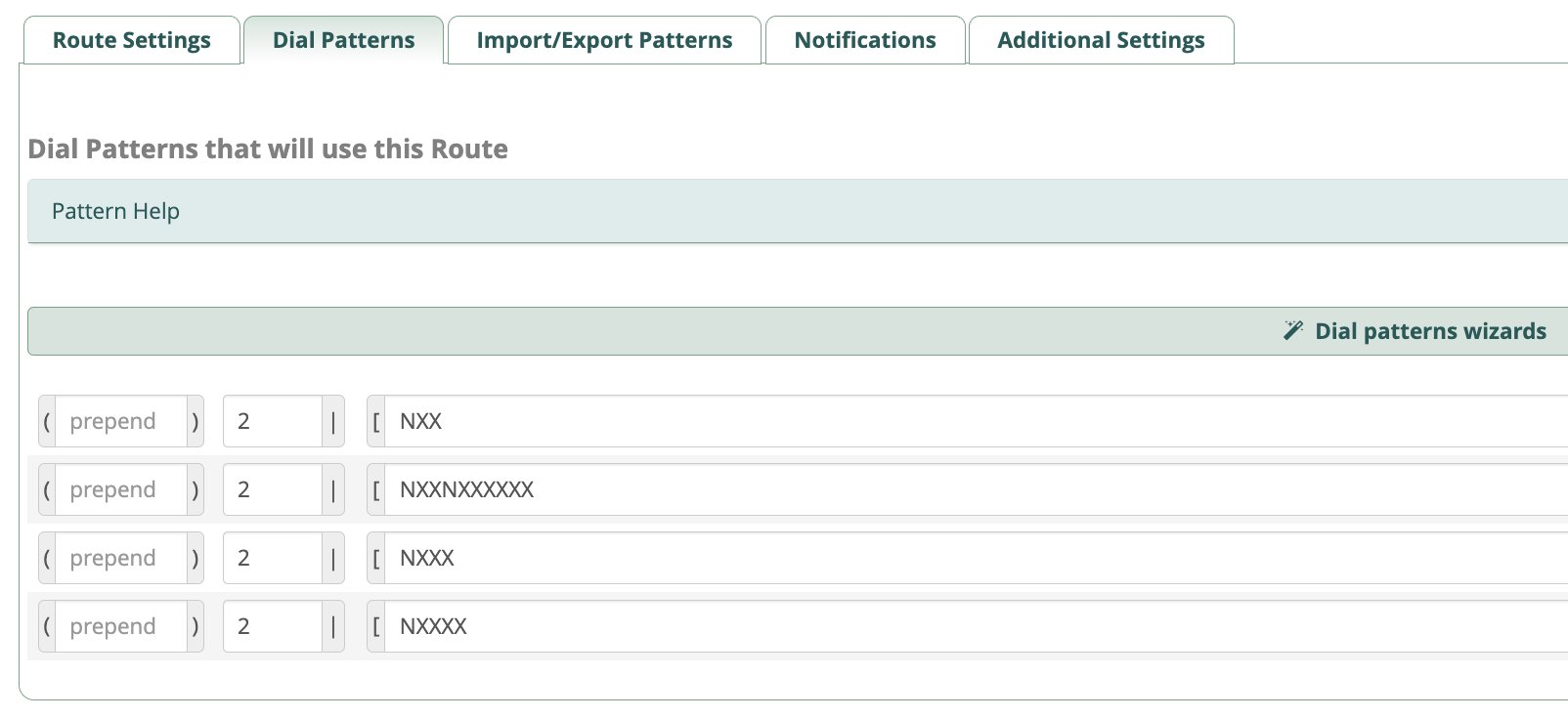
Repeating the Setup Process in Other Cities
Now simply repeat the steps above on each of your PBXs. For PJsip trunks, you’ll need to create one for every other city in your operation. And, for Outbound Routes, do the same. Once all of your PJsip trunks are activated, you can verify functionality in the Asterisk CLI with this command: pjsip show aors. Once the Status for each city displays as Avail, you can begin making test calls between the servers using a phone connected to each PBX.
Originally published: Tuesday, May 16, 2023

Need help with Asterisk? Visit the VoIP-info Forum.
Special Thanks to Our Generous Sponsors
FULL DISCLOSURE: ClearlyIP, Skyetel, Vitelity, DigitalOcean, Vultr, VoIP.ms, 3CX, Sangoma, TelecomsXchange and VitalPBX have provided financial support to Nerd Vittles and our open source projects through advertising, referral revenue, and/or merchandise. As an Amazon Associate and Best Buy Affiliate, we also earn from qualifying purchases. We’ve chosen these providers not the other way around. Our decisions are based upon their corporate reputation and the quality of their offerings and pricing. Our recommendations regarding technology are reached without regard to financial compensation except in situations in which comparable products at comparable pricing are available from multiple sources. In this limited case, we support our sponsors because our sponsors support us.
 BOGO Bonaza: Enjoy state-of-the-art VoIP service with a $10 credit and half-price SIP service on up to $500 of Skyetel trunking with free number porting when you fund your Skyetel account. No limits on number of simultaneous calls. Quadruple data center redundancy. $25 monthly minimum spend required. Tutorial and sign up details are here.
BOGO Bonaza: Enjoy state-of-the-art VoIP service with a $10 credit and half-price SIP service on up to $500 of Skyetel trunking with free number porting when you fund your Skyetel account. No limits on number of simultaneous calls. Quadruple data center redundancy. $25 monthly minimum spend required. Tutorial and sign up details are here.
 The lynchpin of Incredible PBX 2020 and beyond is ClearlyIP components which bring management of FreePBX modules and SIP phone integration to a level never before available with any other Asterisk distribution. And now you can configure and reconfigure your new Incredible PBX phones from the convenience of the Incredible PBX GUI.
The lynchpin of Incredible PBX 2020 and beyond is ClearlyIP components which bring management of FreePBX modules and SIP phone integration to a level never before available with any other Asterisk distribution. And now you can configure and reconfigure your new Incredible PBX phones from the convenience of the Incredible PBX GUI.
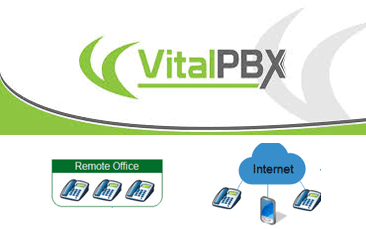 VitalPBX is perhaps the fastest-growing PBX offering based upon Asterisk with an installed presence in more than 100 countries worldwide. VitalPBX has generously provided a customized White Label version of Incredible PBX tailored for use with all Incredible PBX and VitalPBX custom applications. Follow this link for a free test drive!
VitalPBX is perhaps the fastest-growing PBX offering based upon Asterisk with an installed presence in more than 100 countries worldwide. VitalPBX has generously provided a customized White Label version of Incredible PBX tailored for use with all Incredible PBX and VitalPBX custom applications. Follow this link for a free test drive!
 Special Thanks to Vitelity. Vitelity is now Voyant Communications and has halted new registrations for the time being. Our special thanks to Vitelity for their unwavering financial support over many years and to the many Nerd Vittles readers who continue to enjoy the benefits of their service offerings. We will keep everyone posted on further developments.
Special Thanks to Vitelity. Vitelity is now Voyant Communications and has halted new registrations for the time being. Our special thanks to Vitelity for their unwavering financial support over many years and to the many Nerd Vittles readers who continue to enjoy the benefits of their service offerings. We will keep everyone posted on further developments.

Interconnecting Asterisk Servers with PJsip and OpenVPN

It’s been several years since we discussed interconnecting Asterisk® servers so today we want to do a version refresh using PJsip Trunking. We also want to show you how easy it is to secure the communications path by setting up the trunks using OpenVPN connections. When we’re finished, you’ll have a FREE way to call between sites using FreePBX® Outbound Routes. Because Incredible PBX comes preconfigured with all the components you’ll need, we’ll use that platform to further simplify the deployment. We’ll be interconnecting two Asterisk servers today, but you can use the same methodology to connect numerous sites.
Deploying OpenVPN with Asterisk Servers
To begin, you’ll want to get all of the sites configured with a virtual private network using OpenVPN. Our tutorial will walk you through the process. Keep in mind that all current releases of Incredible PBX are preconfigured to let you drop in your OpenVPN client credentials by naming them incrediblepbx.ovpn and copying the file into the /etc directory. Rebooting your server will bring up the virtual private network with a 10.8.0.x IP address.
Configuring PJsip Trunks on Your Asterisk Servers
If you remember yesteryear’s knuckle drill configuring SIP or IAX trunks for Asterisk connectivity, you’re in for a pleasant surprise using PJsip trunking with FreePBX. Using the GUI, create a new PJsip trunk for every site to which you want to establish a connection. A similar PJsip trunk must be created on the other site as well. If you’re just interconnecting two servers, then using the City locations for the Trunk Names will suffice. But, if there are more than two servers, specify unique names for each end of every PJsip connection, e.g.
NewYork1 <-> London1 NewYork2 <-> Washington1 NewYork3 <-> Miami1 London2 <-> Washington2 London3 <-> Miami2 Washington3 <-> Miami3
For today, we’ll interconnect a server in New York and London, but we’ll plan for the future and use London1 for the Trunk Name on the New York server and NewYork1 for the Trunk Name on the London server.
Let’s begin by configuring the London1 trunk on the New York server. After entering the London1 Trunk Name in the General tab, click on the pjsip Settings tab. In the General tab, leave the defaults in the first four fields. Then change the Registration field to None. For the SIP Server field, enter the OpenVPN IP address of the London server, e.g. 10.8.0.2. Because we’re using Incredible PBX, the PJsip port is 5061 so enter that in the SIP Server Port field. If you’re using a different flavor of FreePBX, enter the appropriate port number for PJsip on your platform. Next, click on the Advanced tab and enter the London server’s OpenVPN address in the Match (Permit) field, e.g. 10.8.0.2. In the Codecs tab, make note of the enabled codecs and make certain that the entries match on all of your servers. Click the Submit button to save your settings and then reload your dialplan.
Now let’s configure the NewYork1 trunk on the London server. After entering the NewYork1 Trunk Name in the General tab, click on the pjsip Settings tab. In the General tab, leave the defaults in the first four fields. Then change the Registration field to None. For the SIP Server field, enter the OpenVPN IP address of the New York server, e.g. 10.8.0.1. Because we’re using Incredible PBX, the PJsip port is 5061 so enter that in the SIP Server Port field. If you’re using a different flavor of FreePBX, enter the appropriate port number for PJsip on your platform. Next, click on the Advanced tab and enter the New York server’s OpenVPN address in the Match (Permit) field, e.g. 10.8.0.1. In the Codecs tab, make certain that the entries match those on your New York server. Click the Submit button to save your settings and then reload your dialplan. Here’s how it looks in the FreePBX GUI:
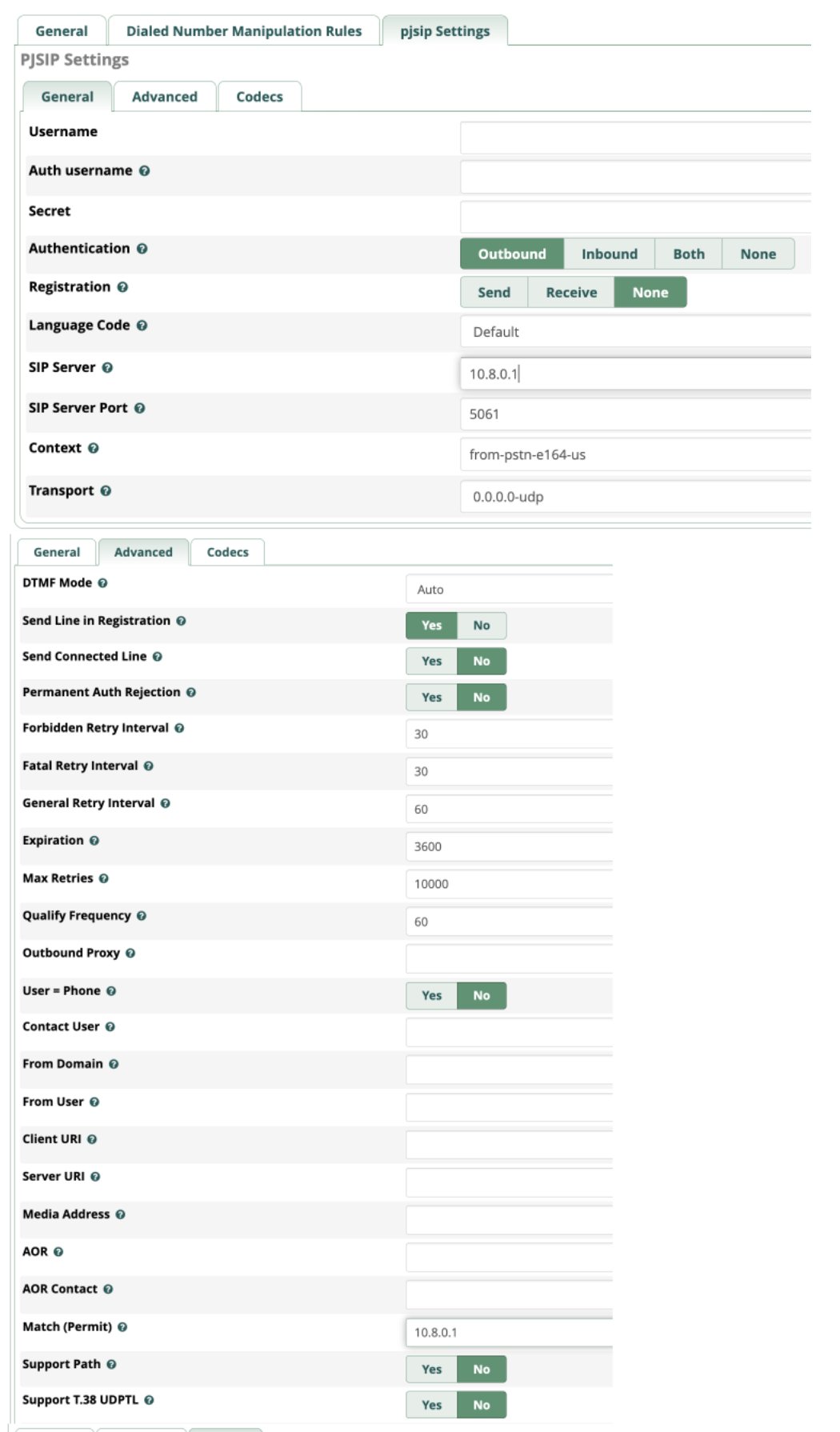
Use Outbound Routes to Interconnect Extensions
To keep things simple, let’s assume both your New York and London servers have extensions 701-705. To call an extension on the other server, we will simply dial 9 and then the 3-digit extension, e.g. dialing 9701 on the New York server will ring 701 on the London server and dialing 9701 on the London server will ring 701 on the New York server.
Create an Outbound Route on the New York server called London specifying London1 for the Trunk Sequence in the Route Settings tab. In the Dial Patterns tab, enter 9 in the Prefix field and XXX for the Match Pattern. Click Submit to save your settings and then reload dialplan.

Create an Outbound Route on the London server called New York specifying NewYork1 for the Trunk Sequence in the Route Settings tab. In the Dial Patterns tab, enter 9 in the Prefix field and XXX for the Match Pattern. Click Submit to save your settings and then reload dialplan.
If you’re interconnecting more than two sites, then you probably will want to designate a specific Prefix for every City so that users can travel between sites and use the same methodology to reach the same extensions from every location.
You can test things out using softphones by registering 701 to an extension in New York and another to the 701 extension in London. Now you can place secure and FREE calls between the sites by dialing 9701 from each softphone. Enjoy!
Originally published: Monday, May 2, 2022

Need help with Asterisk? Visit the VoIP-info Forum.
Special Thanks to Our Generous Sponsors
FULL DISCLOSURE: ClearlyIP, Skyetel, Vitelity, DigitalOcean, Vultr, VoIP.ms, 3CX, Sangoma, TelecomsXchange and VitalPBX have provided financial support to Nerd Vittles and our open source projects through advertising, referral revenue, and/or merchandise. As an Amazon Associate and Best Buy Affiliate, we also earn from qualifying purchases. We’ve chosen these providers not the other way around. Our decisions are based upon their corporate reputation and the quality of their offerings and pricing. Our recommendations regarding technology are reached without regard to financial compensation except in situations in which comparable products at comparable pricing are available from multiple sources. In this limited case, we support our sponsors because our sponsors support us.
 BOGO Bonaza: Enjoy state-of-the-art VoIP service with a $10 credit and half-price SIP service on up to $500 of Skyetel trunking with free number porting when you fund your Skyetel account. No limits on number of simultaneous calls. Quadruple data center redundancy. $25 monthly minimum spend required. Tutorial and sign up details are here.
BOGO Bonaza: Enjoy state-of-the-art VoIP service with a $10 credit and half-price SIP service on up to $500 of Skyetel trunking with free number porting when you fund your Skyetel account. No limits on number of simultaneous calls. Quadruple data center redundancy. $25 monthly minimum spend required. Tutorial and sign up details are here.
 The lynchpin of Incredible PBX 2020 and beyond is ClearlyIP components which bring management of FreePBX modules and SIP phone integration to a level never before available with any other Asterisk distribution. And now you can configure and reconfigure your new Incredible PBX phones from the convenience of the Incredible PBX GUI.
The lynchpin of Incredible PBX 2020 and beyond is ClearlyIP components which bring management of FreePBX modules and SIP phone integration to a level never before available with any other Asterisk distribution. And now you can configure and reconfigure your new Incredible PBX phones from the convenience of the Incredible PBX GUI.
 VitalPBX is perhaps the fastest-growing PBX offering based upon Asterisk with an installed presence in more than 100 countries worldwide. VitalPBX has generously provided a customized White Label version of Incredible PBX tailored for use with all Incredible PBX and VitalPBX custom applications. Follow this link for a free test drive!
VitalPBX is perhaps the fastest-growing PBX offering based upon Asterisk with an installed presence in more than 100 countries worldwide. VitalPBX has generously provided a customized White Label version of Incredible PBX tailored for use with all Incredible PBX and VitalPBX custom applications. Follow this link for a free test drive!
 Special Thanks to Vitelity. Vitelity is now Voyant Communications and has halted new registrations for the time being. Our special thanks to Vitelity for their unwavering financial support over many years and to the many Nerd Vittles readers who continue to enjoy the benefits of their service offerings. We will keep everyone posted on further developments.
Special Thanks to Vitelity. Vitelity is now Voyant Communications and has halted new registrations for the time being. Our special thanks to Vitelity for their unwavering financial support over many years and to the many Nerd Vittles readers who continue to enjoy the benefits of their service offerings. We will keep everyone posted on further developments.

Introducing OpenSIPS 3 for Incredible PBX and Debian 10

Today we’re pleased to introduce an updated OpenSIPS installer for Debian 10 featuring the latest release of OpenSIPS. Our previous tutorial with Debian 8 is now obsolete, an all-too-frequent occurrence in the open source world. Today’s open source SIP server lets you connect users to make and receive free as well as commercial calls worldwide. There’s excellent documentation making it easy to integrate into our existing Incredible PBX platform without hiring a consultant. It’s also straight-forward to secure without providing free phone service to every bad guy on the planet.
OpenSIPS is a multi-functional, multi-purpose signaling SIP server used by carriers, telecoms or ITSPs for solutions like Class4/5 Residential Platforms, Trunking / Wholesale, Enterprise / Virtual PBX Solutions, Session Border Controllers, Application Servers, Front-End Load Balancers, IMS Platforms, Call Centers, and many others. Source: opensips.org
We’ve often complained that the problem with many open source projects is that the developers get so focused on making money that they skimp on the documentation to encourage consulting work or participation in expensive conferences. We have found just the opposite with OpenSIPS. In fact, much of today’s implementation is based upon an excellent tutorial by the folks at PowerPBX. Down the road, if you find yourself in need of a consultant, their services would be a good place to start. What we’ve added to the PowerPBX design is security, support for clients behind NAT-based routers, and an integration scheme for Asterisk®, FreePBX®, and Incredible PBX® platforms so that you get the best of all worlds, a public facing SIP server with the UC feature set that most organizations expect. Last but not least, our turnkey GPLv2 installer will get you up and running in about 5 minutes.
Choosing an Appropriate Platform for OpenSIPS
Let’s begin by addressing the appropriate platform for an OpenSIPS server. The server needs to have a public IP address that is static, and the server should not be situated behind a NAT-based router. It only complicates things and is beyond the scope of what we plan to address. For those that are frequent visitors, you already know that we’ve been pushing everyone to kiss their local hardware goodbye and join the cloud revolution. When it comes to public-facing VoIP platforms like OpenSIPS, most of us don’t have a choice. You need a static IP address on the open Internet. And, for the sake of security, a KVM cloud platform is a must since older OpenVZ platforms don’t support the ipset component of IPtables which makes it easy to block hundreds of thousands of IP addresses without a performance hit on your server. Pure whitelist access simply isn’t an option if you wish to retain the functionality of a VoIP application such as OpenSIPS.
Ten to twenty gigabytes of disk space should be more than ample for OpenSIPS. The amount of RAM in your server depends upon the volume of calls your server will be handling. If it’s a dozen simultaneous calls then 1GB of RAM will suffice. If it’s 100,000 calls, then take a look at this article for tips on sizing your server. For today’s implementation, you’ll need a Debian 10 platform so a low-cost KVM provider including Digital Ocean, Vultr, and OVH should be fine.1
Choosing OpenSIPS Components to Deploy
We’ve divided up today’s tutorial into bite-sized pieces so that you can pick and choose where to stop implementing and start using. You do not need to have an Asterisk server to make and receive calls with OpenSIPS. However, OpenSIPS lacks voicemail and AutoAttendant/IVR components so, if those are a requirement, then you either need a VoIP service provider that offers them, or deploy a $50 Incredible PBX for the Raspberry Pi to add the missing pieces.
What OpenSIPS offers is a free server platform for worldwide SIP communications so that you, your friends, and business associates can call or connect from anywhere using freely available SIP softphones or any of dozens of SIP telephone instruments. We’ll stick with softphones for today, but hardware-based SIP telephones are equally simple to deploy.
This is not a criticism because it is one of the best tutorials we’ve ever used but, if you want to see how complex a typical OpenSIPS server deployment is, take a look at the PowerPBX tutorial we used as a starting point with OpenSIPS. We’ve compressed most of those procedures into a turnkey installer that only requires you to enter a MySQL root password of passw0rd (with a zero) once you have your Debian 10/64 platform up and running.
Deploying a Debian 10 Server Platform
Start by choosing a cloud provider that offers the 64-bit Debian 10 minimal platform as a deployment option. Most do. As noted, we recommend a KVM platform with support for ipset making it easy to block entire countries overrun with bad guys. Choose offerings with at least 1GB RAM and a 10GB drive to get started. Configure your Debian 10 server with a fully-qualified domain name (FQDN). This is critically important with our security design because we will assign all OpenSIPS users/extensions to this FQDN and reserve your server’s IP address purely for connections from service providers and Asterisk servers. This makes it all but impossible for anyone to hack into your server since most script kiddies launch attacks on IP addresses, not FQDNs. Using an unusual FQDN adds an extra layer of security, but that’s your call. If you lack the ability to assign FQDN aliases to a domain which you own, you can obtain a free FQDN from numerous sources including ChangeIP and point it to the IP address of your OpenSIPS server.
Installing OpenSIPS on a Debian 10 Server
Now the fun begins. Log into your Debian 8 server as root and issue the following commands to prepare for the OpenSIPS install:
cd /root wget http://incrediblepbx.com/opensips3.tar.gz tar zxvf opensips3.tar.gz rm -f opensips3.tar.gz
Make sure you have logged into your Debian 10 server as root using SSH or Putty from a desktop PC that you will use to manage OpenSIPS with a browser. The reason is because this IP address automatically will be whitelisted in the OpenSIPS firewall as part of the install process. Otherwise, you will need to manually log into SSH and whitelist the IP address of your desktop PC using /root/add-ip each time you wish to access the OpenSIPS Control Panel since TCP port 80 (HTTP) is not exposed to the public Internet as a security precaution.
To begin the install, issue this command: /root/install
As the install progresses, you’ll first be prompted to choose the GRUB install device. Press the spacebar on the first entry. Then press TAB and ENTER. When prompted for the SSH configuration, choose "keep local version" and then press TAB and ENTER. For the MariaDB setup, press ENTER when prompted for the current password. Type N when prompted whether to switch to unix_socket authorization. Then type Y to change the root password. Be sure to use passw0rd (with a zero) as your MySQL password, or the install will fail. This is NOT a security risk unless your Debian 10 root user account is compromised. And, in that case, it won’t matter anyway since the MySQL password could easily be changed. Type Y to remove anonymous users. Type Y to disallow remote root logins. Type Y to reload the MySQL privilege tables.
Next you’ll be prompted to set your timezone and TZ entries. For East Coast U.S., it’s 2,49,1,1 then America/New_York. Later you’ll be prompted twice for the MySQL root password. You must enter passw0rd (with a zero). When the OpenSIPS status screen displays, type Q to exit the display. There are a couple of steps where you will be prompted for input. Correct responses are indicated before the various prompts. Pay particular attention when you are prompted to change the SSH port from TCP 22 to a port number in the 1000-2020 range as a security precaution. We recommend using the year you were born because it will be easy for you to remember. When the install finishes and you log out of your server, the next SSH login will look like this where XXXX is the SSH port you chose and yyy.yyy.yyy.yyy is the OpenSIPS server address: ssh -p XXXX root@yyy.yyy.yyy.yyy
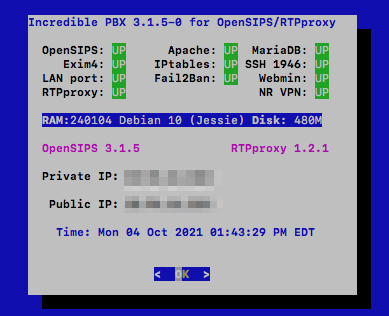
Although most of the configuration of your OpenSIPS server will be handled using a web browser and the OpenSIPS Control Panel GUI, we’ve included a few scripts in /root to assist with maintenance of your server platform. Here’s a brief summary of the script functions:
- pbxstatus – Status of your OpenSIPS server (image sample above)
- add-ip – Temporarily WhiteList IP address until next iptables-restart
- ban-ip – Permanently Ban an IP address
- unban-ip – Unban a previously banned IP address
- log-purge – Zero out all of the major Linux log files
- opensips-check – Assures OpenSIPS and RTPproxy are running (runs automatically)
- Fail2Ban BlackLists –
iptables -nL | grep -A100000 "opensips (" - IPset BlackList (KVM/OVZ7 platforms only) –
ipset list | sort
We secure your server in several ways: (1) by disguising the SSH port, (2) by locking down almost every port on your server with the IPtables firewall with the exception of the SIP ports, (3) by deploying Fail2Ban to scan your OpenSIPS log for errors and lock out attackers for an extended period of time, and (4) by deploying the IPset blacklist for KVM platforms. With this design, there is a symbiotic relationship between IPtables, Fail2Ban, and IPset. Therefore, it is critically important that you only restart these services using the iptables-restart command. NEVER issue other IPtables commands to restart or save your firewall settings.
Activating a SIP Server with OpenSIPS Control Panel
We don’t want to overload you on the first day with your new OpenSIPS 3 platform so we’ll walk you through the preliminary setup steps to create your SIP Domain. Then we’ll show you how to set up user accounts (also known as extensions). Finally we’ll walk you through setting up a trunk to make and receive calls from a commercial SIP provider. When we’re finished today, you’ll be able to make and receive calls using SIP URIs or DIDs which you have purchased from a provider. Then next week we’ll focus on integration of OpenSIPS with an Asterisk platform of your choice using Incredible PBX as an example. Once we’re finished, you’ll be able to handle user account registrations exclusively on your OpenSIPS server while leaving your Asterisk platform completely hidden from public exposure.
Logging into the OpenSIPS Control Panel
As deployed, the OpenSIPS Control Panel is accessible via web browser. As noted previously, HTTP Port 80 access is blocked by default unless the IP address of your desktop PC has been whitelisted either as part of the initial install or using the add-ip script in /root. Once your desktop PC’s IP address is whitelisted, point your browser to http://xxx.xxx.xxx.xxx/cp
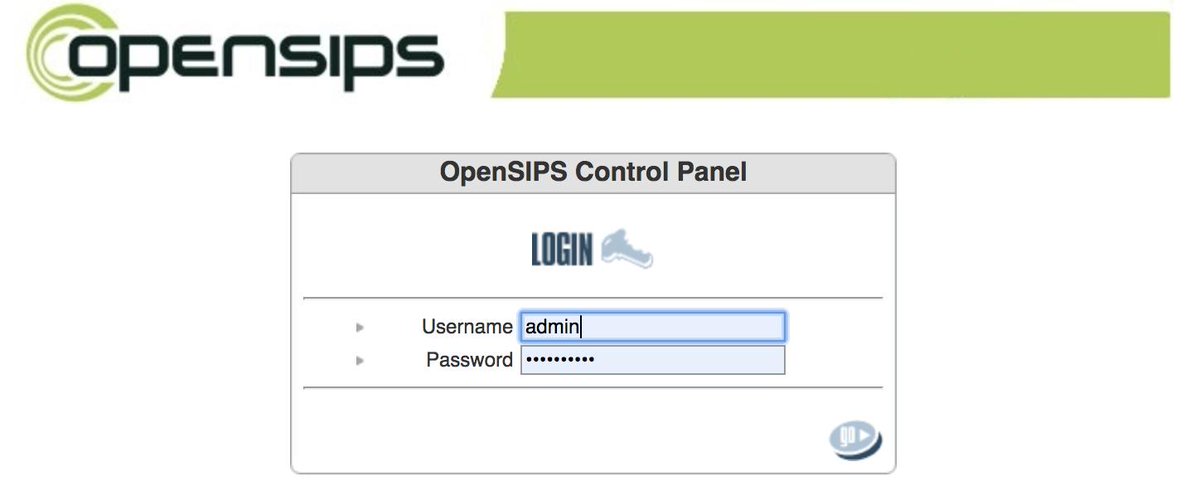
The default Username is admin, and the default password is opensips. Once you’re logged in, immediately click on the Users icon in the upper-right corner of the dashboard. Then click the Edit Info pencil icon for user Admin and change your password. Click Save when done.
Creating Domains with OpenSIPS Control Panel
In the Left column of the Dashboard, you’ll see two tabs: Users and System. Click on the System tab to expose the available choices. Then choose the Domains option.

Domains are the essential building blocks in OpenSIPS. You can manage one or a hundred domains on a single OpenSIPS server, and each domain can have its own set of Users, Trunks/Gateways, and Dialplan rules. We’re actually going to create two domains, one for the IP Address of your OpenSIPS server and a second one for the FQDN of your OpenSIPS server. For added security, we will create all User accounts under the FQDN Domain. And we’ll reserve the IP Address Domain for DID Trunks/Gateways from registered, commercial SIP providers. This design allows attackers to attempt to register to accounts on your IP Address Domain until the cows come home, and they will never be successful because there are no existing SIP user accounts there. Keep it that way! With our OpenSIPS design, Fail2Ban will block attackers after a single failed registration attempt. And OpenSIPS itself will identify and block all SIP flood attacks using either Fail2Ban or IPset.
Now that you understand the design, let’s set up your domains. After choosing System -> Domains, enter the IP Address of your OpenSIPS server at the SIP Domain prompt. Then click Add New Domain followed by Reload on Server. Repeat the same steps to enter the fully-qualified domain name (FQDN) of your OpenSIPS server. When finished, you should see:
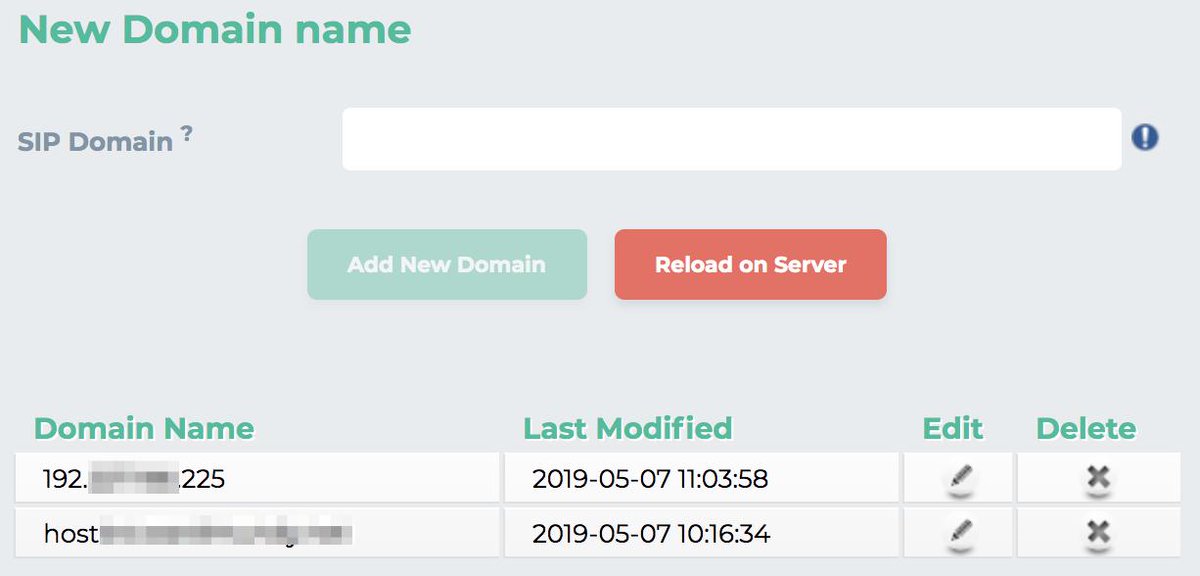
Creating Users with OpenSIPS Control Panel
We’ve already explained the security implications and reason for creating User accounts with your FQDN Domain only. Click on Users -> User Management -> Add New to get started. You can use Numbers (what we call Extensions in Asterisk) or Names. Our preference is to use Numbers for the User accounts and then to create Alias Names (as desired) for each User account. You can’t dial names from most SIP telephones. This also keeps the design similar to what many are used to in the Asterisk environment. A completed dialog would look something like the following. Use the Domain pull-down to choose your FQDN. Obviously, the passwords must be secure and must match. Then the Register button will be enabled to save. The actual Numbers used for Usernames are completely up to you.

Create at least a couple User accounts so that you can set up two SIP phones to call yourself and verify that everything is working. These User accounts become an integral part of the SIP URI to receive calls from any SIP phone in the world:
7701@opensips.yourdomain.com
Before you can actually answer an incoming call to your SIP URI, you’ll need to register the User account using either a softphone or SIP phone. We’ll do that next. But, first, let’s create an Alias to 7701 User so that folks can reach you by calling joe@opensips.yourdomain.com
Click on Users -> Alias Management -> Add New Alias to get started. Fill in the form using the example below. Make sure that you select your FQDN Domain using the pull-downs for BOTH the Domain and Alias Domain fields. Then click Add to save.

Registering a Softphone to an OpenSIPS User Account
There are literally dozens of free SIP soft phones from which to choose. We covered some of our favorites for every platform in previous articles. For our purposes today, we recommend you choose one of the Linphone softphones which are available for the PC, Mac, Linux, Android, and iOS platforms. We also recommend signing up for a free Linphone.org SIP account which doesn’t cost you anything. For today, we will be configuring the softphone to register to your new OpenSIPS server.
Once you have downloaded and installed the Linphone client, go into the Preferences menu and make the following changes. Some depend upon your calling platform.
- Audio Codecs: PCMU, G722, PCMA
- Video Codecs: VP8, H264
- Call Encryption: None
- DTMF: RFC2833 only
- Send InBand DTMF: OFF
- Send SIP INFO DTMF: OFF
- SIP UDP 5060: Enabled
- SIP TCP 5060: Enabled
- Allow IPv6: Disabled
Then set up a new SIP Proxy account: Username (7701), Password (as defined), Domain: your FQDN not IP address, Transport: UDP, Outbound Proxy: OFF, Stun Server: stun.linphone.org, ICE: ON, AVPF: OFF, Push Notification: ON, Country Code Prefix: 1 (if required by your commercial SIP provider), Register: YES, Account Enabled: YES. HINT: You can call Alias Names via SIP URI, but you can only register to a SIP account using its actual Username.
Avoiding Lockouts with NeoRouter VPN
By design, Fail2Ban is unforgiving when it comes to failed registrations. A single failed registration will get an IP address banned for a full week. The reason is because the new bad guy strategy is to hit your server once to determine whether anybody is home. Then the creep bombards you later with an endless stream of registration attempts. With our design, nobody will be home when they return. The bad news is a single failed registration attempt by you or your users will also trigger a ban. There are several workarounds. The easiest is to set up the NeoRouter client on each of your machines including your OpenSIPS server and use the 10.0.0.x private network for access. These IP addresses never get banned. Our previous tutorial will walk you through setting up a free NeoRouter server and installing the free NeoRouter clients on your machines. The client software already is installed and running on your OpenSIPS server. It only requires that you log in using nrclientcmd and register to your NeoRouter server to obtain a private IP address. The other option is to install OpenVPN. Our previous tutorial will walk you through that process. The advantage of OpenVPN is that it’s supported directly on many SIP telephone instruments. The 10.8.0.x addresses are already whitelisted by our OpenSIPS installer.
There are other options to unban an IP address which has accidentally been snagged. First, almost all of the cloud providers include a Console option in their web portals. Second, you can log into your server via SSH from any non-blacklisted IP address to remove the banned IP address. Once you’re logged in, simply run this command using the IP address you wish to unban: /root/unban-ip xxx.xxx.xxx.xxx
Choosing Commercial SIP Providers
Recall that you cannot register to a SIP alias on your OpenSIPS server. We’ll take advantage of this restriction in setting up incoming calls from commercial providers’ DIDs. To set up Trunks from commercial providers so that you can not only receive incoming calls but also make outbound calls over their PSTN network connections, you must use providers that support IP address authentication rather than a SIP registration. Many providers support this including our platinum sponsor, Skyetel, as well as providers such as VoIP.ms, Anveo Direct, V1VoIP, and many others. In our OpenSIPS design, you also can use DIDs from providers that support SIP URI forwarding such as CallCentric and LocalPhone; however, you are limited to receiving inbound calls only. VoIP communications really shines here because you don’t have to choose a single provider to meet all of your communications requirements.
Skyetel is by far the easiest provider to set up with OpenSIPS. See our earlier tutorial for a special offer that will get you half-price calling for up to $500. Effective 10/1/2023, $25/month minimum spend required. Once you’re registered on the Skyetel site, add a new EndPoint Group using the IP address of your OpenSIP server and designate UDP 5060 as the access port. Sign up for a DID and map it to the OpenSIPS Endpoint Group. Done. In the OpenSIPS Control Panel, navigate to System -> Dynamic Routing and click Add Gateway. Using the template below, create 5 Proxy gateways for the following Skyetel data centers:
- skyetel-NW 52.41.52.34
- skyetel-SW 52.8.201.128
- skyetel-NE 52.60.138.31
- skyetel-SE 50.17.48.216
- skyetel-EU 35.156.192.164
Begin by whitelisting the IP addresses of your SIP providers in /etc/iptables/rules.v4 just below the existing 10.8.0.0/24 rule. The entries should look like this:
-I INPUT -s 52.41.52.34 -j ACCEPT
Once you’ve entered IP addresses for your providers, issue the command: iptables-restart
Next, we need to create what Asterisk users know as an Outbound Route. This tells OpenSIPS to send dialed numbers in 11-digit format to Skyetel for termination. We’ve already created the Dial Plan rule for calling out by dialing 1 plus a 10-digit number. So, while you’re still in the Dynamic Routing section of the OpenSIPS Control Panel, click on the Rules tab at the top of the template. Then click Add Rule. Begin by clicking Add ID button and choosing Group ID 0. In the Prefix field, type 1. Now click the Add GW button 3 times after choosing the Skyetel gateways in the following order from the GW pull-down list: skyetel-nw, skyetel-sw, and skyetel-se. Those are the three currently operational Skyetel gateways. When you’re finished, your template should look like the following. Then click the Add button to save the new rule. Click Reload Server to load the new rule into OpenSIPS. Then repeat this procedure leaving the Prefix field blank so that you can make 10-digit calls as well.
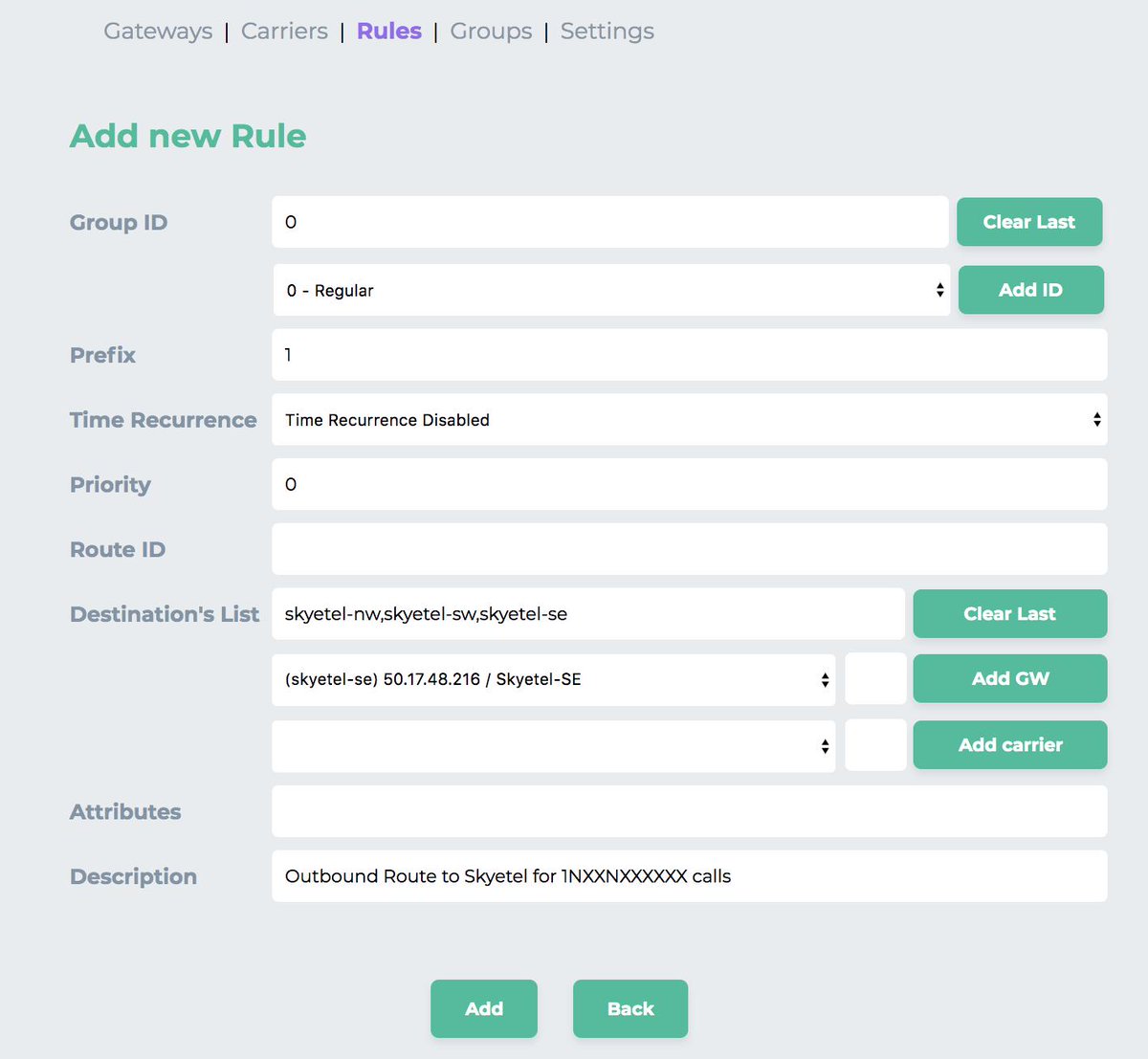
Finally, we need to create what Asterisk users know as an Inbound Route. This tells OpenSIPS where to send incoming calls from our Skyetel DID. OpenSIPS handles inbound routes by defining a User Alias for the Username to which you want to route the incoming DID calls. Click on Users -> Alias Management -> Add New Alias to get started. Fill in the form using the following template and then click Add.
- Username: 7701 (the extension to which to route the incoming calls)
- Domain: opensips.xyz.com (the FQDN of your OpenSIPS server)
- Alias Username: 18435551212 (the 11-digit Skyetel DID)
- Alias Domain: 11.12.13.14 (the IP address of your OpenSIPS server)
- Alias Type: dbaliases
Introducing the VoIP Blacklist
We’ve always dreamed of an effective VoIP Blacklist, and many have tried. But the crowd-sourced VoIP Blacklist at voipbl.org is the real deal. Everybody can post entries (including the bad guys) and, magically, most of the illegitimate entries get sifted out before the next day’s list is released. The list gets populated every night while you sleep. Here are the steps to install the VoIP Blacklist with IPset:
apt update && apt install ipset iptables netfilter-persistent ipset-persistent iptables-persistent cd /usr/local/sbin wget http://incrediblepbx.com/voipbl-update chmod +x voipbl-update sed -i 's|fail2ban restart|fail2ban restart\n/usr/local/sbin/voipbl-update|' iptables-restart iptables-restart ipset list voipbl ipset list voipbl | wc -l
Then create a cron job in /etc/crontab to run /usr/local/sbin/voipbl-update every day to update the VoIP blacklist.
1 4 * * * root /usr/local/sbin/voipbl-update > /dev/null 2>&1
Congratulations! You now have a functioning OpenSIPS 3 server that can process incoming calls from SIP URIs as well as DIDs. And you can make SIP URI and 11-digit PSTN calls using your SIP softphone that’s registered to your OpenSIPS server. See you next week. Enjoy!
Continue Reading: Best of Both Worlds: Safely Marrying Asterisk to OpenSIPS
Originally published: Monday, October 4, 2021

Need help with Asterisk? Visit the VoIP-info Forum.
Special Thanks to Our Generous Sponsors
FULL DISCLOSURE: ClearlyIP, Skyetel, Vitelity, DigitalOcean, Vultr, VoIP.ms, 3CX, Sangoma, TelecomsXchange and VitalPBX have provided financial support to Nerd Vittles and our open source projects through advertising, referral revenue, and/or merchandise. As an Amazon Associate and Best Buy Affiliate, we also earn from qualifying purchases. We’ve chosen these providers not the other way around. Our decisions are based upon their corporate reputation and the quality of their offerings and pricing. Our recommendations regarding technology are reached without regard to financial compensation except in situations in which comparable products at comparable pricing are available from multiple sources. In this limited case, we support our sponsors because our sponsors support us.
 BOGO Bonaza: Enjoy state-of-the-art VoIP service with a $10 credit and half-price SIP service on up to $500 of Skyetel trunking with free number porting when you fund your Skyetel account. No limits on number of simultaneous calls. Quadruple data center redundancy. $25 monthly minimum spend required. Tutorial and sign up details are here.
BOGO Bonaza: Enjoy state-of-the-art VoIP service with a $10 credit and half-price SIP service on up to $500 of Skyetel trunking with free number porting when you fund your Skyetel account. No limits on number of simultaneous calls. Quadruple data center redundancy. $25 monthly minimum spend required. Tutorial and sign up details are here.
 The lynchpin of Incredible PBX 2020 and beyond is ClearlyIP components which bring management of FreePBX modules and SIP phone integration to a level never before available with any other Asterisk distribution. And now you can configure and reconfigure your new Incredible PBX phones from the convenience of the Incredible PBX GUI.
The lynchpin of Incredible PBX 2020 and beyond is ClearlyIP components which bring management of FreePBX modules and SIP phone integration to a level never before available with any other Asterisk distribution. And now you can configure and reconfigure your new Incredible PBX phones from the convenience of the Incredible PBX GUI.
 VitalPBX is perhaps the fastest-growing PBX offering based upon Asterisk with an installed presence in more than 100 countries worldwide. VitalPBX has generously provided a customized White Label version of Incredible PBX tailored for use with all Incredible PBX and VitalPBX custom applications. Follow this link for a free test drive!
VitalPBX is perhaps the fastest-growing PBX offering based upon Asterisk with an installed presence in more than 100 countries worldwide. VitalPBX has generously provided a customized White Label version of Incredible PBX tailored for use with all Incredible PBX and VitalPBX custom applications. Follow this link for a free test drive!
 Special Thanks to Vitelity. Vitelity is now Voyant Communications and has halted new registrations for the time being. Our special thanks to Vitelity for their unwavering financial support over many years and to the many Nerd Vittles readers who continue to enjoy the benefits of their service offerings. We will keep everyone posted on further developments.
Special Thanks to Vitelity. Vitelity is now Voyant Communications and has halted new registrations for the time being. Our special thanks to Vitelity for their unwavering financial support over many years and to the many Nerd Vittles readers who continue to enjoy the benefits of their service offerings. We will keep everyone posted on further developments.

- Nerd Vittles receives referral fees from some VoIP service providers to help cover the costs of our blog. We never recommend particular companies solely to generate commissions. We also test all services that we recommend. [↩]
Is SIP Trunking Safe & Reliable in the DDoS World?

Since last Thursday when VoIP.ms suffered (and continues to suffer) one of the worst Distributed Denial of Service (DDOS) attacks in the VoIP era, we’ve been asked a thousand times whether any SIP trunking provider can provide a safe and reliable platform under circumstances similar to the VoIP.ms outage. We obviously cannot vouch for every trunking provider but, based upon our discussions with two of the major carriers that support Incredible PBX, we are confident that either of them could withstand a similar attack and your phones would still ring. Keep in mind that one of the hidden beauties of VoIP is the ability to configure your PBX to use multiple carriers for failover in making outbound calls, something we have always recommended. Unfortunately, inbound calls are tied to registration of each DID with one and only one carrier. Thus, if that carrier goes off line, incoming calls to DIDs registered with that carrier will fail.
To restate the obvious, no provider is going to publicly document their DDOS remediation methodology thereby providing attackers with a blueprint to their network design and remediation strategy. However, under non-disclosure agreements, we have spoken at length with the owners of our two major Incredible PBX providers: Skyetel and Clearly IP. Based upon our NDA discussions over the past few days, we are satisfied that the SIP trunking offerings of our two primary carriers are sufficiently robust to withstand a VoIP.ms-like DDOS attack. Having said that, we are optimistic that the VoIP.ms outage has placed a renewed spotlight on the seriousness of these DDOS attacks with the FBI and the U.S. Department of Homeland Security.
So what’s missing from the VoIP.ms design that has made their infrastructure so vulnerable? Lots. For openers, VoIP.ms apparently does not rely upon SIP proxies or firewalls using industry-standard network management procedures. In fact, until several days ago, VoIP.ms reportedly was hosting its own DNS servers exclusively. While that has been addressed by moving to Cloudflare, other design vulnerabilities have been more difficult to ameliorate. For example, SIP trunking with VoIP.ms by design requires registration to one of several dozen POPs on both your PBX and on their public-facing portal. An inability to access their public portal means an administrator cannot redirect traffic to another POP in case of an outage. And, if an individual POP is overwhelmed with a DDOS attack, that POP can no longer redirect its incoming calls to a failover location. And apparently it is the only server from which this redirection can be initiated. As the current five-day outage makes clear, reengineering this design would be a Herculean task. So an important lesson learned should be that FORWARDING DIDS TO ANOTHER NUMBER OR SIP ADDRESS SHOULD BE COMPLETELY INDEPENDENT OF YOUR PUBLIC-FACING ARCHITECTURE.
What can you do at this juncture to lessen your vulnerability to a future DDOS attack? First, don’t put all of your eggs in one carrier’s basket. This is especially true with your main phone numbers (DIDs). Second, if you are a major organization, move your most important DIDs to one of our preferred providers, Skyetel or ClearlyIP. And, if money is no object, consider an AT&T, Verizon, T-Mobile, or Google Voice trunk. With multi-path forwarding, simultaneous incoming calls can be redirected to other DIDs hosted with SIP trunking providers. These paths can easily be adjusted in the event of a DDOS attack. Many of these providers offer heavily discounted rates for forwarding calls to other SIP destinations which need not be publicly disclosed.
Latest VoIP.ms Update:

Originally published: Monday, September 20, 2021

Need help with Asterisk? Visit the VoIP-info Forum.
Special Thanks to Our Generous Sponsors
FULL DISCLOSURE: ClearlyIP, Skyetel, Vitelity, DigitalOcean, Vultr, VoIP.ms, 3CX, Sangoma, TelecomsXchange and VitalPBX have provided financial support to Nerd Vittles and our open source projects through advertising, referral revenue, and/or merchandise. As an Amazon Associate and Best Buy Affiliate, we also earn from qualifying purchases. We’ve chosen these providers not the other way around. Our decisions are based upon their corporate reputation and the quality of their offerings and pricing. Our recommendations regarding technology are reached without regard to financial compensation except in situations in which comparable products at comparable pricing are available from multiple sources. In this limited case, we support our sponsors because our sponsors support us.
 BOGO Bonaza: Enjoy state-of-the-art VoIP service with a $10 credit and half-price SIP service on up to $500 of Skyetel trunking with free number porting when you fund your Skyetel account. No limits on number of simultaneous calls. Quadruple data center redundancy. $25 monthly minimum spend required. Tutorial and sign up details are here.
BOGO Bonaza: Enjoy state-of-the-art VoIP service with a $10 credit and half-price SIP service on up to $500 of Skyetel trunking with free number porting when you fund your Skyetel account. No limits on number of simultaneous calls. Quadruple data center redundancy. $25 monthly minimum spend required. Tutorial and sign up details are here.
 The lynchpin of Incredible PBX 2020 and beyond is ClearlyIP components which bring management of FreePBX modules and SIP phone integration to a level never before available with any other Asterisk distribution. And now you can configure and reconfigure your new Incredible PBX phones from the convenience of the Incredible PBX GUI.
The lynchpin of Incredible PBX 2020 and beyond is ClearlyIP components which bring management of FreePBX modules and SIP phone integration to a level never before available with any other Asterisk distribution. And now you can configure and reconfigure your new Incredible PBX phones from the convenience of the Incredible PBX GUI.
 VitalPBX is perhaps the fastest-growing PBX offering based upon Asterisk with an installed presence in more than 100 countries worldwide. VitalPBX has generously provided a customized White Label version of Incredible PBX tailored for use with all Incredible PBX and VitalPBX custom applications. Follow this link for a free test drive!
VitalPBX is perhaps the fastest-growing PBX offering based upon Asterisk with an installed presence in more than 100 countries worldwide. VitalPBX has generously provided a customized White Label version of Incredible PBX tailored for use with all Incredible PBX and VitalPBX custom applications. Follow this link for a free test drive!
 Special Thanks to Vitelity. Vitelity is now Voyant Communications and has halted new registrations for the time being. Our special thanks to Vitelity for their unwavering financial support over many years and to the many Nerd Vittles readers who continue to enjoy the benefits of their service offerings. We will keep everyone posted on further developments.
Special Thanks to Vitelity. Vitelity is now Voyant Communications and has halted new registrations for the time being. Our special thanks to Vitelity for their unwavering financial support over many years and to the many Nerd Vittles readers who continue to enjoy the benefits of their service offerings. We will keep everyone posted on further developments.

Linphone Rocks: Free SIP Calling to Anybody, Anywhere

We’re rounding out our softphone series today with the perfect complement to Clearly Anywhere for Asterisk® and FreePBX®. Let’s face it. SIP URI dialing from extensions is not Asterisk’s strong suit which is disappointing since SIP URI calling is free. If you’ve been following Incredible PBX® 2020 developments this year, you already know that we’ve pushed everyone to move their VoIP servers to the cloud. You not only get a more flexible PUBLIC platform that lets you go virtually anywhere while preserving home base connectivity for a few bucks a month. A public Asterisk server also lets anyone in the world call your PBX via a SIP URI, and the calls are free from any SIP phone. HINT: Linphone softphones are free!
Today we want to take a fresh look at one of our favorites, Linphone. We call it the perfect complement to Clearly Anywhere because it installs on almost every platform and provides SIP URI communications without any dependence upon a PBX at all. And, just like Clearly Anywhere, multiple devices can connect to the same Linphone account to make and receive calls. Linphone offers free SIP clients for Windows, Mac, Linux, iOS, Android, and many browsers. There’s even GPL source code if that’s your thing. Here are the download links:
- Windows
- Mac
- Linux
- iOS via App Store
- Android via Google Play
- Web Browser (Chrome, Edge, Firefox, Safari)
- GPL v3 Source Code
To get started, sign up for a free Linphone account. Now simply download the app of your choice from the links above and run it. Then choose the Assistant option and plug in your username and password. Be sure to Allow Push Notifications so that your phone will ring whenever you get an incoming call. Now all you need is a cellular data plan or a wired or wireless network connection. Anyone can reach you at yourname@sip.linphone.org. When friends sign up, their calls also will be free. You can talk as often and as long as you like.
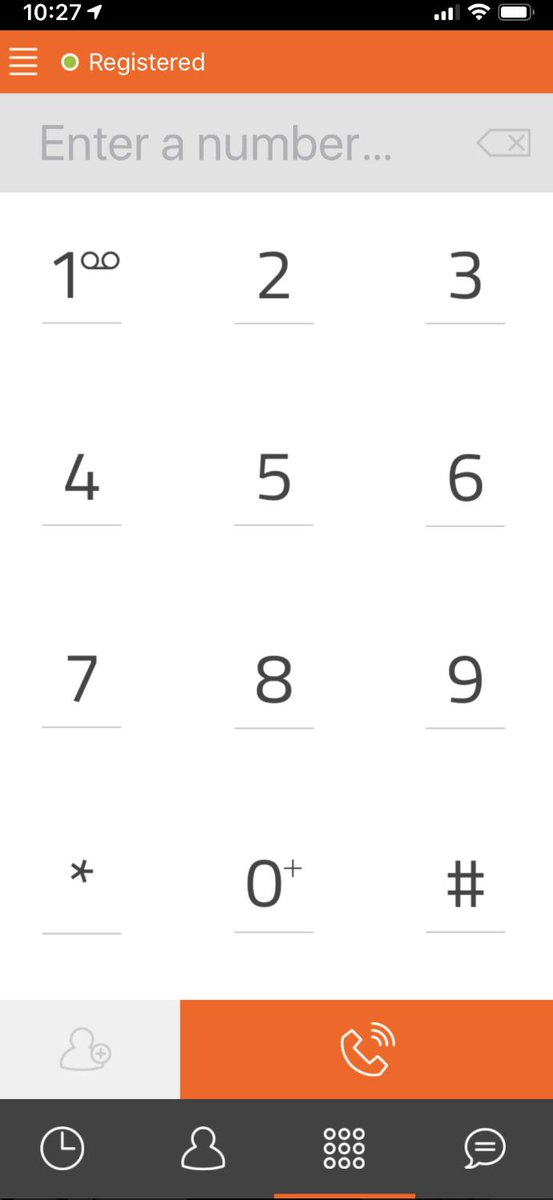
Should you ever lose or forget your password. here’s a link that will let you reset it.
The Linphone feature set is downright impressive. Here’s what you and your friends will be using at zero cost:
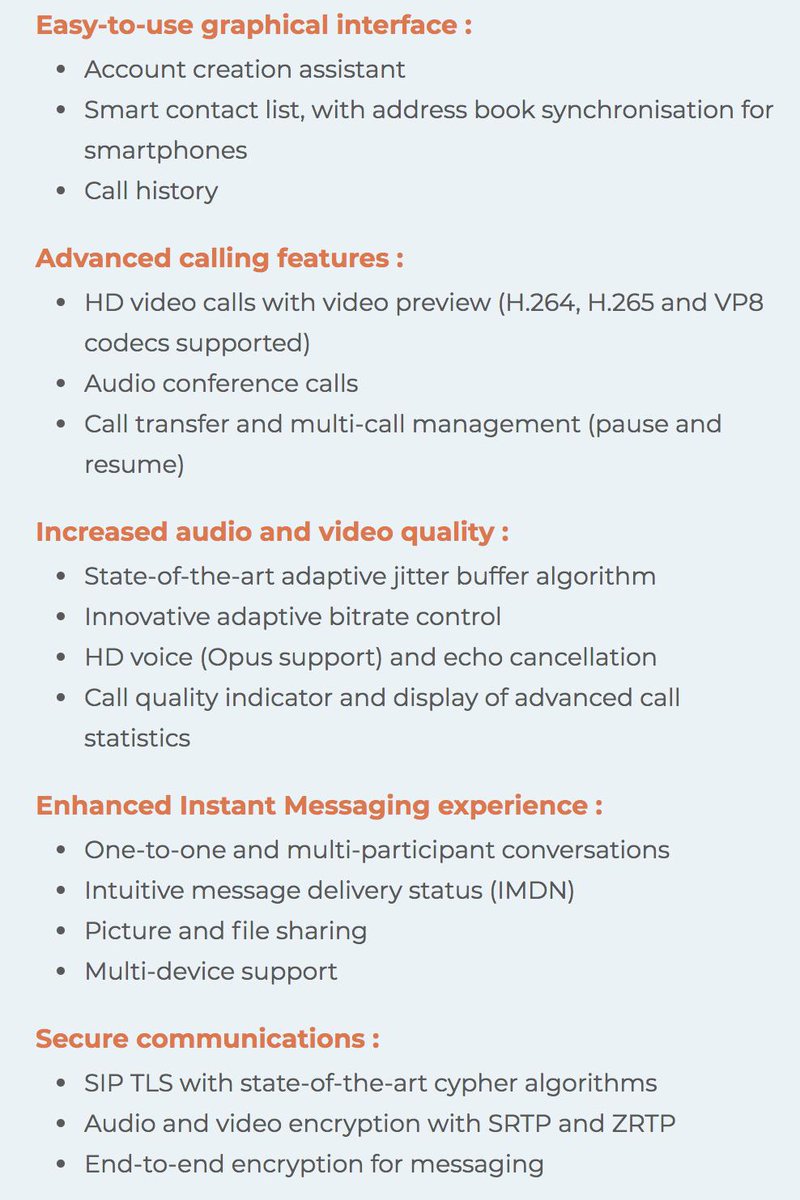
CONFIGURATION TIPS: Missing audio or one-way audio is a common problem on SIP calls especially if your phone is sitting behind a NAT-based router. For best results, configure your account in the Linphone app to use UDP for the Transport, Disable the Outbound Proxy, configure stun.linphone.org as the Stun Server, and enable ICE. In Network settings, turn off IPv6 and Media Encryption. In Audio Settings, enable Opus, G.722, PCMU, and PCMA only. In Video Settings, enable both VP8 and H.264. Then close the app and reopen it.
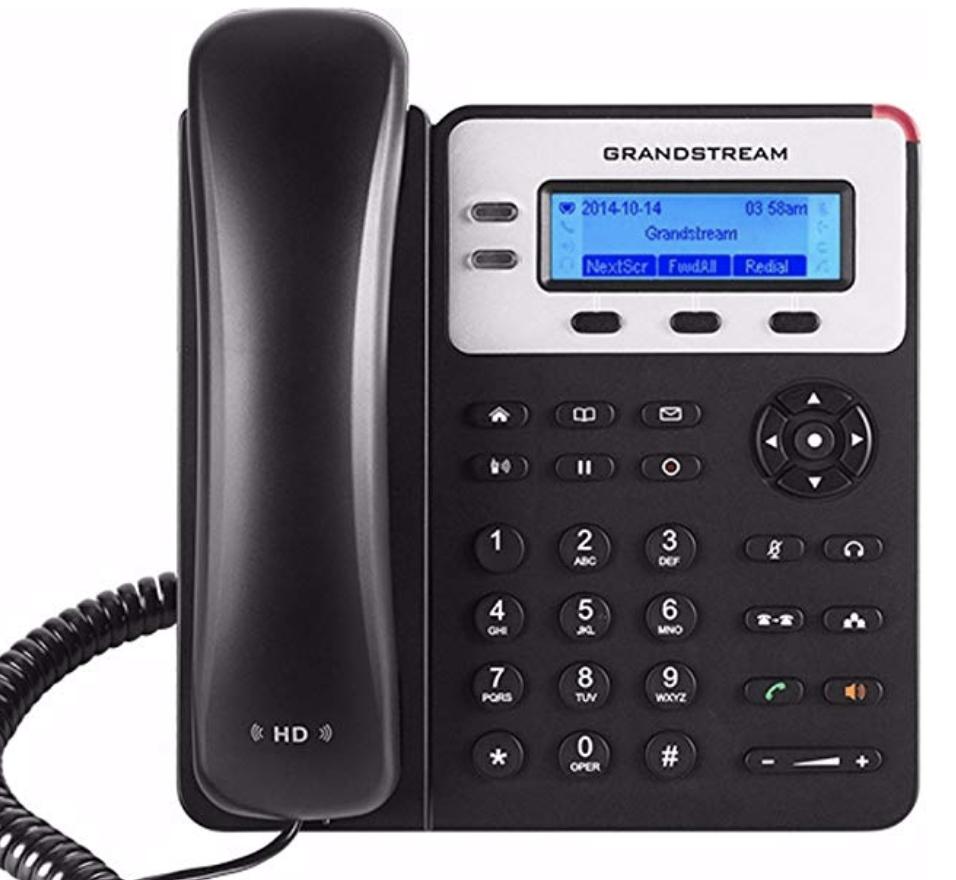
Once you have your Linphone credentials, another option in addition to using one of the SIP clients above is to acquire a stand-alone SIP telephone which can easily be connected to your Linphone SIP account. While there are literally hundreds of SIP telephones from which to choose, here’s a $40 offering from Grandstream that we like. It’s available from Amazon.1 Also consider Incredible PBX phones which take SIP communications to a whole new level.

Unlike other proprietary communications apps, the beauty of using Linphone with its native SIP URI support is you can call any SIP phone in the world for free whether the recipient uses Linphone or not. For example, to annoy your friends and spammers, you can transfer their calls to Lenny: 2233435945@sip2sip.info. And here are some other SIP URI calls you might want to try. Store any or all of them in your Linphone Phonebook.
Your Linphone Friend - friend-name@sip.linphone.org Yahoo News Headlines - news@demo.nerdvittles.com Yahoo News Headlines - 951@demo.nerdvittles.com Weather by Zip Code - weather@demo.nerdvittles.com Weather by Zip Code - 947@demo.nerdvittles.com Directory Assistance - information@demo.nerdvittles.com Directory Assistance - 411@demo.nerdvittles.com Call Any TollFree # - **1800XXXXXXX@tollfree.future-nine.com
There are now more than 2,000 VoIP networks worldwide that support SIP URI access. Any person or organization with an account on any of these networks can be reached at no cost via SIP URI or via several hundred PSTN numbers. Using a SIP URI dialing prefix, you can call any referenced network@sipbroker.com. For example, *656news@sipbroker.com would reach the Nerd Vittles News Headlines from Yahoo. Or, from a PSTN phone, choose a local access number from the SipBroker worldwide directory, e.g. 702-789-0530 and then dial *656951 at the prompt for Yahoo News from Nerd Vittles. Call enabled PBX extensions the same way.
If you want to associate a phone number with your Linphone SIP URI, you can do it in a couple of ways. First, using a smartphone, you can link your cell number to Linphone within the Linphone app itself. If you have a free DID from IPComms, you can point it to your Linphone SIP URI. If you have a $1/month CallCentric DID, it can also be pointed to your Linphone SIP URI.
There’s one more nice surprise. Linphone accounts work much like the old key telephones and Google Voice setup that we all knew and loved. What that means is you can register the same Linphone account on multiple phones in different places.
Calling Linphone Users from Incredible PBX
Since Linphone doesn’t technically assign phone numbers to users’ accounts, you still need a way for PBX extensions to contact Linphone users. The easiest way is to create a Custom Extension for every Linphone user account you need to reach. In the FreePBX GUI, navigate to Applications -> Extensions -> Add Extension -> Custom Extension. Assign an Extension Number and Name to the custom extension. Then click on the Advanced tab. In the Dial field, enter the SIP URI for the Linphone user, e.g. SIP/username@sip.linphone.org. Click Submit and then Reload the Dialplan.
Originally published: Monday, October 19, 2020

Need help with Asterisk? Visit the VoIP-info Forum.
Special Thanks to Our Generous Sponsors
FULL DISCLOSURE: ClearlyIP, Skyetel, Vitelity, DigitalOcean, Vultr, VoIP.ms, 3CX, Sangoma, TelecomsXchange and VitalPBX have provided financial support to Nerd Vittles and our open source projects through advertising, referral revenue, and/or merchandise. As an Amazon Associate and Best Buy Affiliate, we also earn from qualifying purchases. We’ve chosen these providers not the other way around. Our decisions are based upon their corporate reputation and the quality of their offerings and pricing. Our recommendations regarding technology are reached without regard to financial compensation except in situations in which comparable products at comparable pricing are available from multiple sources. In this limited case, we support our sponsors because our sponsors support us.
 BOGO Bonaza: Enjoy state-of-the-art VoIP service with a $10 credit and half-price SIP service on up to $500 of Skyetel trunking with free number porting when you fund your Skyetel account. No limits on number of simultaneous calls. Quadruple data center redundancy. $25 monthly minimum spend required. Tutorial and sign up details are here.
BOGO Bonaza: Enjoy state-of-the-art VoIP service with a $10 credit and half-price SIP service on up to $500 of Skyetel trunking with free number porting when you fund your Skyetel account. No limits on number of simultaneous calls. Quadruple data center redundancy. $25 monthly minimum spend required. Tutorial and sign up details are here.
 The lynchpin of Incredible PBX 2020 and beyond is ClearlyIP components which bring management of FreePBX modules and SIP phone integration to a level never before available with any other Asterisk distribution. And now you can configure and reconfigure your new Incredible PBX phones from the convenience of the Incredible PBX GUI.
The lynchpin of Incredible PBX 2020 and beyond is ClearlyIP components which bring management of FreePBX modules and SIP phone integration to a level never before available with any other Asterisk distribution. And now you can configure and reconfigure your new Incredible PBX phones from the convenience of the Incredible PBX GUI.
 VitalPBX is perhaps the fastest-growing PBX offering based upon Asterisk with an installed presence in more than 100 countries worldwide. VitalPBX has generously provided a customized White Label version of Incredible PBX tailored for use with all Incredible PBX and VitalPBX custom applications. Follow this link for a free test drive!
VitalPBX is perhaps the fastest-growing PBX offering based upon Asterisk with an installed presence in more than 100 countries worldwide. VitalPBX has generously provided a customized White Label version of Incredible PBX tailored for use with all Incredible PBX and VitalPBX custom applications. Follow this link for a free test drive!
 Special Thanks to Vitelity. Vitelity is now Voyant Communications and has halted new registrations for the time being. Our special thanks to Vitelity for their unwavering financial support over many years and to the many Nerd Vittles readers who continue to enjoy the benefits of their service offerings. We will keep everyone posted on further developments.
Special Thanks to Vitelity. Vitelity is now Voyant Communications and has halted new registrations for the time being. Our special thanks to Vitelity for their unwavering financial support over many years and to the many Nerd Vittles readers who continue to enjoy the benefits of their service offerings. We will keep everyone posted on further developments.

- This phone requires a wired network connection. Some of our purchase links refer users to Amazon when we find their prices are competitive for the recommended products. Nerd Vittles receives a small referral fee from Amazon to help cover the costs of our blog. We never recommend particular products solely to generate Amazon commissions. However, when pricing is comparable or availability is favorable, we support Amazon because Amazon supports us. [↩]
Android Alert: Unmasking Your Hidden SIP Phone

Perhaps the single most important component in the VoIP toolbox for any PBX deployment that includes traveling users is the softphone whether it’s deployed on notebook computers or smartphones. We’re kicking off football season with reviews of some of our favorite SIP softphones for mobile users. We’ve previously written about Linphone and Zoiper and Telephone. We’ve also sung the praises of earlier releases of Google’s Pixel smartphone which makes a perfect VoIP companion even without a cellphone provider. Today we’re passing along an Android tip from @w1ve on the VoIP-Info.org Forum for anyone needing PBX connectivity while away from the home or office. And it won’t cost you a dime so long as you already have an Android smartphone with either a Wi-Fi connection or a data plan with any cellphone carrier.
You may be unaware that Android has been shipping with a native SIP phone since as far back as Android Marshmallow which will be five years old next month. Some phone manufacturers such as Chinese-owned Lenovo/Moto disable the SIP functionality, but many do not including Google, Samsung, and OnePlus. If you’ve deployed an Incredible PBX 2020 PUBLIC server in the Cloud with a PJsip extension, the beauty of this discovery is that you’ll always have VoIP connectivity through your PBX with only a WiFi connection. No SIM is required!
To determine if your Android smartphone includes the SIP dialer, simply open the native Phone app and tap the three vertical bar icon at the top of the dialer menu. From the pull-down menu, choose Settings, Calls, and Calling Accounts. If your Android smartphone includes support for the native SIP dialer, there will be a SIP Accounts option in the menu.
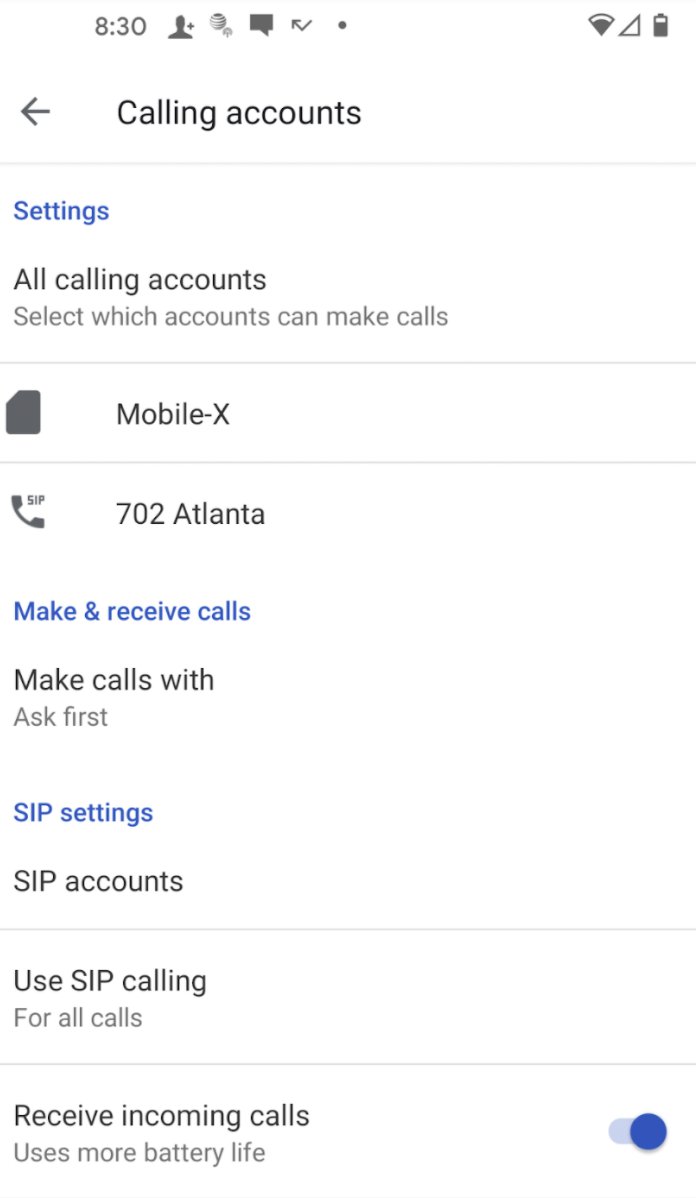
TIP: Even if the SIP Menu doesn’t appear on your smartphone, it may be that the manufacturer simply disabled the menu without actually trashing the SIP functionality as Lenovo has done. To determine whether the menu has simply been hidden, install QuickShortcutMaker from the Play Store. Run the app and scroll down and tap the SIP Settings option and click Test. It should bring up the SIP Accounts menu shown below.
Tapping SIP Accounts and then + icon will open a dialog to add a SIP account to your phone.

With an Incredible PBX 2020 PUBLIC server, the entries should look like the following:
- Username: Your PJsip extension
- Password: Your PJsip password
- Server: FQDN of Your PBX
- Optional Settings -> Port: 5061
Keep in mind that an FQDN for the Server address is required with an Incredible PBX 2020 PUBLIC server. If your server is using a dynamic IP address, you also would want to configure the FQDN using a Dynamic DNS service and refresh that FQDN periodically on your PBX using a cron job. Once you’ve entered your credentials, tap SAVE to activate the SIP account on your smartphone. It should then appear in the SIP Accounts window as shown above.
Next, you have some choices to make as to how the SIP account is actually used. As you can see from our setup (shown above), we allow outbound calls using either the SIM card or the SIP phone, and the phone will prompt for a choice whenever you make a call. We also have activated Inbound SIP calling which, as the dialog explains, uses some battery life. Finally, if you elect to use a chan_SIP extension on your PBX, make certain that you have enabled NAT Mode in the Advanced tab, or you will experience one-way or no audio on calls. This is not required with PJsip extensions. One of the other beauties of PJsip extensions is that you can assign this extension to multiple SIP devices including softphones and desktop phones so long as you increase the Max Contacts entry in the Advanced tab for the PJsip extension. In this way, you can answer incoming calls on your desktop phone when you’re at home or in the office and answer the same calls on your smartphone when you’re out and about. Enjoy!
Originally published: Tuesday, September 1, 2020

Need help with Asterisk? Visit the VoIP-info Forum.
Special Thanks to Our Generous Sponsors
FULL DISCLOSURE: ClearlyIP, Skyetel, Vitelity, DigitalOcean, Vultr, VoIP.ms, 3CX, Sangoma, TelecomsXchange and VitalPBX have provided financial support to Nerd Vittles and our open source projects through advertising, referral revenue, and/or merchandise. As an Amazon Associate and Best Buy Affiliate, we also earn from qualifying purchases. We’ve chosen these providers not the other way around. Our decisions are based upon their corporate reputation and the quality of their offerings and pricing. Our recommendations regarding technology are reached without regard to financial compensation except in situations in which comparable products at comparable pricing are available from multiple sources. In this limited case, we support our sponsors because our sponsors support us.
 BOGO Bonaza: Enjoy state-of-the-art VoIP service with a $10 credit and half-price SIP service on up to $500 of Skyetel trunking with free number porting when you fund your Skyetel account. No limits on number of simultaneous calls. Quadruple data center redundancy. $25 monthly minimum spend required. Tutorial and sign up details are here.
BOGO Bonaza: Enjoy state-of-the-art VoIP service with a $10 credit and half-price SIP service on up to $500 of Skyetel trunking with free number porting when you fund your Skyetel account. No limits on number of simultaneous calls. Quadruple data center redundancy. $25 monthly minimum spend required. Tutorial and sign up details are here.
 The lynchpin of Incredible PBX 2020 and beyond is ClearlyIP components which bring management of FreePBX modules and SIP phone integration to a level never before available with any other Asterisk distribution. And now you can configure and reconfigure your new Incredible PBX phones from the convenience of the Incredible PBX GUI.
The lynchpin of Incredible PBX 2020 and beyond is ClearlyIP components which bring management of FreePBX modules and SIP phone integration to a level never before available with any other Asterisk distribution. And now you can configure and reconfigure your new Incredible PBX phones from the convenience of the Incredible PBX GUI.
 VitalPBX is perhaps the fastest-growing PBX offering based upon Asterisk with an installed presence in more than 100 countries worldwide. VitalPBX has generously provided a customized White Label version of Incredible PBX tailored for use with all Incredible PBX and VitalPBX custom applications. Follow this link for a free test drive!
VitalPBX is perhaps the fastest-growing PBX offering based upon Asterisk with an installed presence in more than 100 countries worldwide. VitalPBX has generously provided a customized White Label version of Incredible PBX tailored for use with all Incredible PBX and VitalPBX custom applications. Follow this link for a free test drive!
 Special Thanks to Vitelity. Vitelity is now Voyant Communications and has halted new registrations for the time being. Our special thanks to Vitelity for their unwavering financial support over many years and to the many Nerd Vittles readers who continue to enjoy the benefits of their service offerings. We will keep everyone posted on further developments.
Special Thanks to Vitelity. Vitelity is now Voyant Communications and has halted new registrations for the time being. Our special thanks to Vitelity for their unwavering financial support over many years and to the many Nerd Vittles readers who continue to enjoy the benefits of their service offerings. We will keep everyone posted on further developments.

BulkVS: A Bargain SIP Provider for Incredible PBX Platforms

At every opportunity I always tell new VoIP enthusiasts that one of the true advantages of switching to a VoIP platform is the fact that you don’t have to put all your eggs in one basket. Just this morning, I read a Facebook post from one of the elders in my family lamenting the fact that her MaBell landline had failed in the midst of this week’s snowstorm in North Carolina. Her local WiFi and cable TV still worked but not her landline or cellphone.
With that background, we are pleased to introduce BulkVS trunking as another option to add to your collection. Unlike Skyetel, ClearlyIP, Vitelity, and VoIP.ms, we receive no commissions from BulkVS so chalk this article up as a good example of biting off your nose to spite your face. There is a PayPal link to the right if you’re feeling grateful. 😉
Why does BulkVS matter? In the words of Alex Trebek, it’s The 3 P’s: Price, Price, and Price. An inbound US48 Tier0 phone number (DID) will set you back 6¢ a month with a 25¢ setup fee. And calls are billed at $.0003 per minute. Toll-free numbers in the U.S. and Canada are 14¢ a month with a per minute rate of $.0055. CNAM lookups are $.002. Outbound calls are $0.004/minute. E911 service is 49¢/month. Billing increment: 6 seconds. Those aren’t typos.
Getting Started with BulkVS
To get started, click the sign up link on the main BulkVS page. Then fund your account with $25 using PayPal. Or you can sign up for Net 15 billing and pay by check or credit card if you’re not in a rush to get started.
BulkVS offers two ways to set up your BulkVS trunking: IP-based authentication and SIP registration. If you don’t have a firewall which means you’re not using Incredible PBX, the first method is a little safer because nobody can spoof the IP address of your Asterisk® PBX. But it’s not for everyone. For example, if you’re behind a NAT-based firewall or if your server has a dynamic IP address, then IP-based authentication really isn’t an option. Similarly, if you don’t have control of the router that your PBX is sitting behind, then IP-based authentication won’t work since you have to forward both the SIP port (UDP 5060) and the RTP ports (10000-20000) to your PBX. The beauty of SIP registrations is they work from almost anywhere including double-NAT environments. So today, we’ll cover the SIP registration approach which will work for everyone.
There are three setup procedures: one using the BulkVS Control Panel, a second using the Linux CLI, and a third using the FreePBX® GUI included in Incredible PBX®.
BulkVS Setup with SIP Registration
Step 1: Go to Inbound -> DIDs – Purchase and buy one or more DIDs for your PBX.
Step 2: Go to Interconnection -> Host – Add and add your PBX’s public IP address. Leave the port as 5060 for both chan_sip and chan_pjsip setups.
Step 3: Go to Interconnection -> Trunk Group – Add and create a Trunk Group.
Step 4: Go to Interconnection -> Trunk Group – Manage and add the Primary IP Address for your new Trunk Group. Set Delivery Type to 11DIGITS.
Step 5: Go to Interconnection -> SIP Registration and write down the credentials for one of the SIP credentials you wish to use to register your new trunks.
Step 6: Go to Inbound -> DIDs – Manage and select each telephone number. Then set the Trunk Group to the SIPREG Trunk Group you chose in the previous step. Click Update button.
Step 7: Wait 15 minutes for the new IP and Trunk Group settings to propagate to SBC nodes.
Linux CLI Setup for BulkVS
First, log into your server as root and edit iptables-custom in /usr/local/sbin. Add the following just above the # End of Trusted Provider Section marker:
# BulkVS WhiteList /usr/sbin/iptables -A INPUT -p udp -m udp -s 162.249.171.198 --dport 5060:5069 -j ACCEPT /usr/sbin/iptables -A INPUT -p udp -m udp -s 76.8.29.198 --dport 5060:5069 -j ACCEPT /usr/sbin/iptables -A INPUT -p udp -m udp -s 69.12.88.198 --dport 5060:5069 -j ACCEPT /usr/sbin/iptables -A INPUT -p udp -m udp -s 192.9.236.42 --dport 5060:5069 -j ACCEPT /usr/sbin/iptables -A INPUT -p udp -m udp -s 52.206.134.245 --dport 5060:5069 -j ACCEPT
For chan_sip trunk implementations, while logged into your server as root, edit sip_custom_post.conf in /etc/asterisk. Add the following:
[bulkvs1](bulkvs); host=192.9.236.42 [bulkvs2](bulkvs); host=162.249.171.198 [bulkvs3](bulkvs); host=69.12.88.198 [bulkvs4](bulkvs); host=76.8.29.198 [bulkvs5](bulkvs); host=52.206.134.245
Finally, restart the IPtables firewall and reload Asterisk:
iptables-restart fwconsole reload
FreePBX PJsip Setup with SIP Registration
The PJsip alternative is considerably easier. First, you don’t need sip_custom_post.conf entries at all. To begin, navigate to Connectivity -> Trunks and choose Add a PJsip trunk. Name the trunk BulkVS and then click on the pjsip Settings tab. Fill out the form as shown below substituting the BulkVS registration account name you chose above. Any of the three SIP registrations offered for your account under Interconnection -> SIP Registration in the BulkVS Dashboard will work as long as you use the matching password.
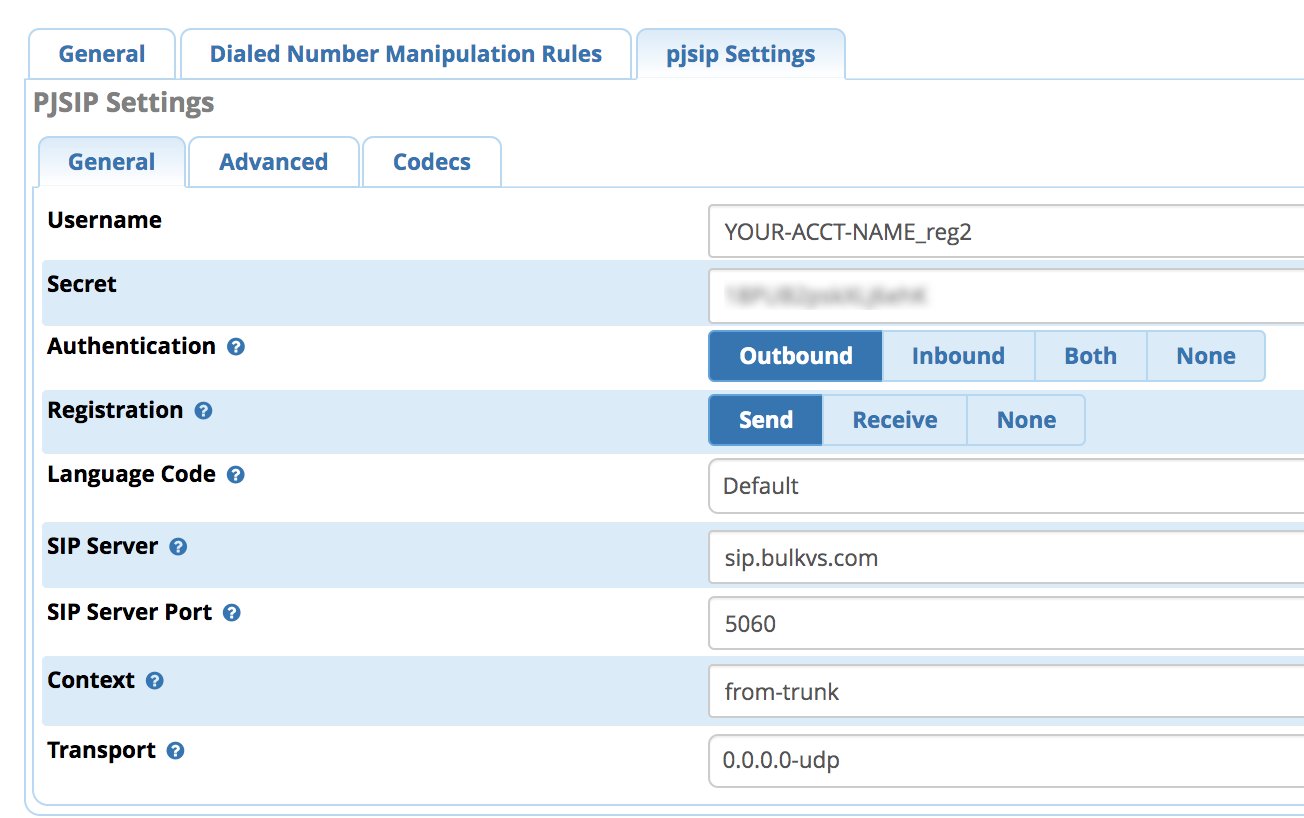
Next, click on the Advanced tab and enter the following in the Match (Permit) field.
162.249.171.198,76.8.29.198,69.12.88.198,192.9.236.42,52.206.134.245
In the Codecs tab, enable ULAW and ALAW. Then click Submit and reload your dialplan.
With PJsip registrations, you may also need to add the following lines to the end of extensions_custom.conf in /etc/asterisk using your actual DID. Then reload your dialplan: asterisk -rx "dialplan reload"
[from-sip-external]
; BulkVS
exten => 18005551212,3,Goto(from-trunk,${DID},1)
FreePBX chan_sip Setup with SIP Registration
If you prefer to set up your BulkVS trunk the old-fashioned way, navigate to Connectivity -> Trunks -> Add chan_sip trunk and enter:

In the Incoming tab, enter a Registration String in the following format where 19991234567 is one of your actual BulkVS DIDs. Then Save the settings and reload the dialplan.
yourBulkVSacctname:yourBulkVSpassword@sip.bulkvs.com/19991234567
Finally, navigate to Settings -> Asterisk SIP Settings and the chan_SIP tab, then set the Registration Minimum Expiry and Registration Default Expiry entries to 25. Then click Submit and reload the dialplan.
FreePBX Inbound & Outbound Route Configuration
Finally, we need to tell FreePBX how to route BulkVS calls into and out of your PBX. In the FreePBX GUI under Connectivty -> Inbound Routes, add a new route for BulkVS specifying the 11-digit DID you purchased from BulkVS. Choose a Destination for the incoming calls, save your settings, and reload the dialplan. Repeat this process for each of your BulkVS DIDs. HINT: The monthly cost of the DIDs is inexpensive enough to assign a DID to every extension on your PBX.
Next, navigate to Connectivity -> Outbound Routes and create a new Outbound Route for calls you wish to process using BulkVS termination services. Name the Outbound Route BulkVS and assign the bulkvs trunk as the first entry in the call sequence. In the Dial Patterns tab, you would want match patterns for 1NXXNXXXXXX and NXXNXXXXXX. For the latter entry, be sure to add a Prepend entry of 1. Then save your settings and reload the dialplan.
SMS Message Delivery from BulkVS Trunks
BulkVS also supports SMS messaging on most of their DIDs. To deliver SMS messages from BulkVS, you’ll need a public-facing web server (not Incredible PBX). Assuming you already have that in place, delivery of SMS messages from BulkVS DIDs to your email address or smartphone’s messaging app is straight-forward. Begin by enabling SMS messaging on your DID: Inbound -> DIDs Manage. Next, assign a web address to process the incoming messages on your web server, e.g. http://yourdomain.com/bulkvs-sms/index.php. Then create the index.php file using the sample code below after inserting your email address for delivery of the incoming messages:
<?php
// Syntax for delivery from bulkvs.com SMS Forwarding Service
$deliverto = "yourname@yourdomain.org";
// $deliverto = "18431234567@txt.att.net";
$from = htmlspecialchars($_REQUEST['from']);
$to = htmlspecialchars($_REQUEST['to']);
$message = htmlspecialchars($_REQUEST['message']);
$subject="SMS Message from $from to $to";
$comment="SMS Message\\n\\nFROM: $from\\n\\nTO: $to\\n\\nMSG: $message\\n\\n";
mail("$deliverto", "$subject", "$comment", "$from");
echo "OK";
?>
To send an SMS message from one of your BulkVS DIDs, you’ll need your API credentials from the BulkVS web site. Simply insert them together with one of your 11-digit DIDs in the script below, and you can send SMS messages to your heart’s content.
from="18005551212"
apikey="aaabbbccc"
apisecret="dddeeefff"
if [ -z "$1" ]; then
echo 'Syntax: send-sms-bulkvs 18005551212 "Your SMS message"'
exit
fi
if [ -z "$2" ]; then
echo 'Syntax: send-sms-bulkvs 18005551212 "Your SMS message"'
exit
fi
to=$1
msg=$2
curl --header "Content-Type: application/json" --request POST --data \\
'{"apikey":"'"$apikey"'","apisecret":"'"$apisecret"'","from":"'"$from"'","to":"'"$to"'","message":"'"$msg"'"}' \\
https://portal.bulkvs.com/sendSMS
To send SMS messages from a Windows machine, see this post from @jerrm.
Originally published: Tuesday, May 12, 2020

Need help with Asterisk? Visit the VoIP-info Forum.
Special Thanks to Our Generous Sponsors
FULL DISCLOSURE: ClearlyIP, Skyetel, Vitelity, DigitalOcean, Vultr, VoIP.ms, 3CX, Sangoma, TelecomsXchange and VitalPBX have provided financial support to Nerd Vittles and our open source projects through advertising, referral revenue, and/or merchandise. As an Amazon Associate and Best Buy Affiliate, we also earn from qualifying purchases. We’ve chosen these providers not the other way around. Our decisions are based upon their corporate reputation and the quality of their offerings and pricing. Our recommendations regarding technology are reached without regard to financial compensation except in situations in which comparable products at comparable pricing are available from multiple sources. In this limited case, we support our sponsors because our sponsors support us.
 BOGO Bonaza: Enjoy state-of-the-art VoIP service with a $10 credit and half-price SIP service on up to $500 of Skyetel trunking with free number porting when you fund your Skyetel account. No limits on number of simultaneous calls. Quadruple data center redundancy. $25 monthly minimum spend required. Tutorial and sign up details are here.
BOGO Bonaza: Enjoy state-of-the-art VoIP service with a $10 credit and half-price SIP service on up to $500 of Skyetel trunking with free number porting when you fund your Skyetel account. No limits on number of simultaneous calls. Quadruple data center redundancy. $25 monthly minimum spend required. Tutorial and sign up details are here.
 The lynchpin of Incredible PBX 2020 and beyond is ClearlyIP components which bring management of FreePBX modules and SIP phone integration to a level never before available with any other Asterisk distribution. And now you can configure and reconfigure your new Incredible PBX phones from the convenience of the Incredible PBX GUI.
The lynchpin of Incredible PBX 2020 and beyond is ClearlyIP components which bring management of FreePBX modules and SIP phone integration to a level never before available with any other Asterisk distribution. And now you can configure and reconfigure your new Incredible PBX phones from the convenience of the Incredible PBX GUI.
 VitalPBX is perhaps the fastest-growing PBX offering based upon Asterisk with an installed presence in more than 100 countries worldwide. VitalPBX has generously provided a customized White Label version of Incredible PBX tailored for use with all Incredible PBX and VitalPBX custom applications. Follow this link for a free test drive!
VitalPBX is perhaps the fastest-growing PBX offering based upon Asterisk with an installed presence in more than 100 countries worldwide. VitalPBX has generously provided a customized White Label version of Incredible PBX tailored for use with all Incredible PBX and VitalPBX custom applications. Follow this link for a free test drive!
 Special Thanks to Vitelity. Vitelity is now Voyant Communications and has halted new registrations for the time being. Our special thanks to Vitelity for their unwavering financial support over many years and to the many Nerd Vittles readers who continue to enjoy the benefits of their service offerings. We will keep everyone posted on further developments.
Special Thanks to Vitelity. Vitelity is now Voyant Communications and has halted new registrations for the time being. Our special thanks to Vitelity for their unwavering financial support over many years and to the many Nerd Vittles readers who continue to enjoy the benefits of their service offerings. We will keep everyone posted on further developments.

Lessons Learned: Circling Back for a Second Look at OpenSIPS

Whenever we tackle a new VoIP platform especially for deployment on the open Internet, we think it’s prudent to circle back after a few weeks to review lessons learned and tie up all the loose ends. Today we’ll introduce a number of new KVM cloud providers around the globe at rock-bottom prices plus some new additions to enhance our OpenSIPS firewall design. If you’re just getting started with OpenSIPS, check out the new KVM offerings below and then hop over to our original article which now incorporates all of today’s enhancements. For those that already have deployed OpenSIPS using our previous tutorial, continue reading, and we’ll show you how to deploy the latest and greatest additions.
While we were in the midst of deploying OpenSIPS, Netflix also disclosed four TCP networking kernel vulnerabilities which are especially important to those of us using hosted cloud platforms. Depending upon your provider, these may or may not be patched promptly.
We were reminded this month that reinventing the wheel isn’t always the best solution when it comes to VoIP security. While we’re not throwing in the towel on our BadGuys list, we do want to show you how to supplement it with the VoIP Blacklist from voipbl.org. It adds over 80,000 crowd-sourced IP addresses from around the world. The other lesson learned was that blacklists invariably include some IP addresses of good guys that you actually depend upon. These typically are added to the blacklist by, you guessed it, the bad guys.
With IPtables, the first matching rule always wins so it’s important in structuring firewall rules to insert whitelisted IP addresses BEFORE the blacklist entries so you don’t inadvertently block yourself or some other resource that you actually need. This whitelist should include the IP addresses of your server and workstations as well as the IP addresses of VoIP providers upon whom you rely for communications services. With our OpenSIPS design, the firewall order of preference looks like this: (1) whitelisted IP addresses get full access, (2) blacklisted IP addresses are blocked and get no access, (3) everybody else gets SIP access.
Rather than attempting to patch the Linux kernel on all of the platforms that are being deployed, we think the prudent first step is to narrow the TCP footprint of all public-facing servers. As part of the original OpenSIPS deployment, we already had hidden web access behind the firewall except for specifically enumerated IP addresses. The second most likely TCP vulnerability would be the TCP SIP ports. While we prefer to use UDP ports for SIP access, some prefer TCP. Until the “SACK Panic” vulnerability is patched, we would strongly recommend at least temporarily discontinuing use of TCP as your SIP transport. After all, OpenSIPS is a SIP server, and the TCP SIP port would be the most likely target for mischief.
Turning back to blacklists for a moment, we’ve put together a few simple bash scripts which make it easy to deploy and update your VoIP blacklists. We’ve also developed a script that lets you move IP addresses flagged by Fail2Ban into the ipset SIPFLOOD blacklist while easing the pain of uploading your own blacklisted IP addresses to the voipbl.org site for inclusion in their list. In this way, they will be added in the next day’s blacklist collection for everyone to use. To give you a point of reference, on our half dozen, publicly-exposed honey pot servers, today’s additions to the OpenSIPS firewall have reduced attacks to less than one a day.
Choosing a KVM Platform for OpenSIPS
For those that are frequent visitors, you already know that we’ve been pushing everyone to kiss their local hardware goodbye and join the cloud revolution. When it comes to public-facing VoIP platforms like OpenSIPS, most of us don’t have a choice. You need a static IP address on the open Internet. And, for the sake of security, a KVM cloud platform is a must since OpenVZ platforms don’t support the ipset component of IPtables which makes it easy to block hundreds of thousands of IP addresses without a performance hit on your server. While we previously have identified OpenVZ providers for our Incredible PBX platforms protected by the Travelin’ Man 3 firewall, pure whitelist access simply isn’t an option if you wish to retain the functionality of a VoIP application such as OpenSIPS. So we went on the hunt to identify KVM cloud providers around the world that could offer a KVM VPS with 1GB RAM, 20GB storage, and 1TB of monthly bandwidth for about $25 a year. No small feat! But our friends at LowEndTalk have come through. Read the message thread and find an offer with a site that best meets your requirements. Many of the KVM offers require you to open a ticket to get the special pricing and configuration outlined above. Here’s a short list of our favorites, but remember to only use the KVM offerings below for OpenSIPS!
| Provider | RAM | Disk | Bandwidth | Performance as of 12/1/19 | Cost |
|---|---|---|---|---|---|
| CrownCloud KVM (LA) | 1GB | 20GB + Snapshot | 1TB/month | 598Mb/DN 281Mb/UP 2CPU Core | $25/year Best Buy! |
| Naranjatech KVM (The Netherlands) | 1GB | 20GB | 1TB/month | Hosting since 2005 VAT: EU res. | 20€/year w/code: SBF2019 |
| BudgetNode KVM (LA) | 1GB | 40GB RAID10 | 1TB/month | Also available in U.K PM @Ishaq on LET before payment | $24/year |
| FreeRangeCloud KVM (Ashburn VA, Winnipeg, Freemont CA) | 1GB | 20GB SSD | 3TB/month | Pick EGG loc'n Open ticket for last 5GB SSD | $30/year w/code: LEBEGG30 |
Introducing the VoIP Blacklist
We’ve always dreamed of an effective VoIP Blacklist, and many have tried. But the crowd-sourced VoIP Blacklist at voipbl.org is the real deal. Everybody can post entries (including the bad guys) and, magically, most of the illegitimate entries get sifted out before the next day’s list is released. We’ve made this easy in two ways. First, the list gets populated every night while you sleep. At last count, there were 84,504 IP addresses. And, second, to contribute to the blacklist, run iptables -nL weekly to see if Fail2Ban has snagged any bad guys. If so, simply run the new /root/blacklist utility which will move them into your local blacklist and also format the entries for easy submission to voip.bl whenever you feel the urge. Simply issue the command cat /root/blcklist.txt to display the entries you just blacklisted. Then cut-and-paste the results and post them to the VoIP Blacklist. The whole process takes less than a minute, and you’ll be contributing to a very valuable VoIP resource while also using it.
Upgrading Existing OpenSIPS KVM/OVZ7 Platforms
If you already have installed OpenSIPS using the previous Nerd Vittles tutorial on a KVM or OVZ7 platform, then the rest of today’s article is for you. If you’re just getting started, hop over to our original article which now incorporates all of today’s enhancements including the VoIP Blacklist.
We’ve made today’s upgrade easy. Just download the OpenSIPS upgrade tarball, untar it, and run the included installer. In less than a minute, you’ll have all the new pieces without disturbing your existing configuration.
To get started, log into your KVM or OVZ7 server as root using SSH or Putty and issue these commands:
cd / wget http://incrediblepbx.com/opensips-upgrade1.tar.gz tar zxvf opensips-upgrade1.tar.gz rm -f opensips-upgrade1.tar.gz /root/opensips-upgrade1
Originally published: Monday, June 24, 2019

Need help with Asterisk? Visit the VoIP-info Forum.
Special Thanks to Our Generous Sponsors
FULL DISCLOSURE: ClearlyIP, Skyetel, Vitelity, DigitalOcean, Vultr, VoIP.ms, 3CX, Sangoma, TelecomsXchange and VitalPBX have provided financial support to Nerd Vittles and our open source projects through advertising, referral revenue, and/or merchandise. As an Amazon Associate and Best Buy Affiliate, we also earn from qualifying purchases. We’ve chosen these providers not the other way around. Our decisions are based upon their corporate reputation and the quality of their offerings and pricing. Our recommendations regarding technology are reached without regard to financial compensation except in situations in which comparable products at comparable pricing are available from multiple sources. In this limited case, we support our sponsors because our sponsors support us.
 BOGO Bonaza: Enjoy state-of-the-art VoIP service with a $10 credit and half-price SIP service on up to $500 of Skyetel trunking with free number porting when you fund your Skyetel account. No limits on number of simultaneous calls. Quadruple data center redundancy. $25 monthly minimum spend required. Tutorial and sign up details are here.
BOGO Bonaza: Enjoy state-of-the-art VoIP service with a $10 credit and half-price SIP service on up to $500 of Skyetel trunking with free number porting when you fund your Skyetel account. No limits on number of simultaneous calls. Quadruple data center redundancy. $25 monthly minimum spend required. Tutorial and sign up details are here.
 The lynchpin of Incredible PBX 2020 and beyond is ClearlyIP components which bring management of FreePBX modules and SIP phone integration to a level never before available with any other Asterisk distribution. And now you can configure and reconfigure your new Incredible PBX phones from the convenience of the Incredible PBX GUI.
The lynchpin of Incredible PBX 2020 and beyond is ClearlyIP components which bring management of FreePBX modules and SIP phone integration to a level never before available with any other Asterisk distribution. And now you can configure and reconfigure your new Incredible PBX phones from the convenience of the Incredible PBX GUI.
 VitalPBX is perhaps the fastest-growing PBX offering based upon Asterisk with an installed presence in more than 100 countries worldwide. VitalPBX has generously provided a customized White Label version of Incredible PBX tailored for use with all Incredible PBX and VitalPBX custom applications. Follow this link for a free test drive!
VitalPBX is perhaps the fastest-growing PBX offering based upon Asterisk with an installed presence in more than 100 countries worldwide. VitalPBX has generously provided a customized White Label version of Incredible PBX tailored for use with all Incredible PBX and VitalPBX custom applications. Follow this link for a free test drive!
 Special Thanks to Vitelity. Vitelity is now Voyant Communications and has halted new registrations for the time being. Our special thanks to Vitelity for their unwavering financial support over many years and to the many Nerd Vittles readers who continue to enjoy the benefits of their service offerings. We will keep everyone posted on further developments.
Special Thanks to Vitelity. Vitelity is now Voyant Communications and has halted new registrations for the time being. Our special thanks to Vitelity for their unwavering financial support over many years and to the many Nerd Vittles readers who continue to enjoy the benefits of their service offerings. We will keep everyone posted on further developments.



 JUST RELEASED: Visit the Incredible PBX Wiki
JUST RELEASED: Visit the Incredible PBX Wiki